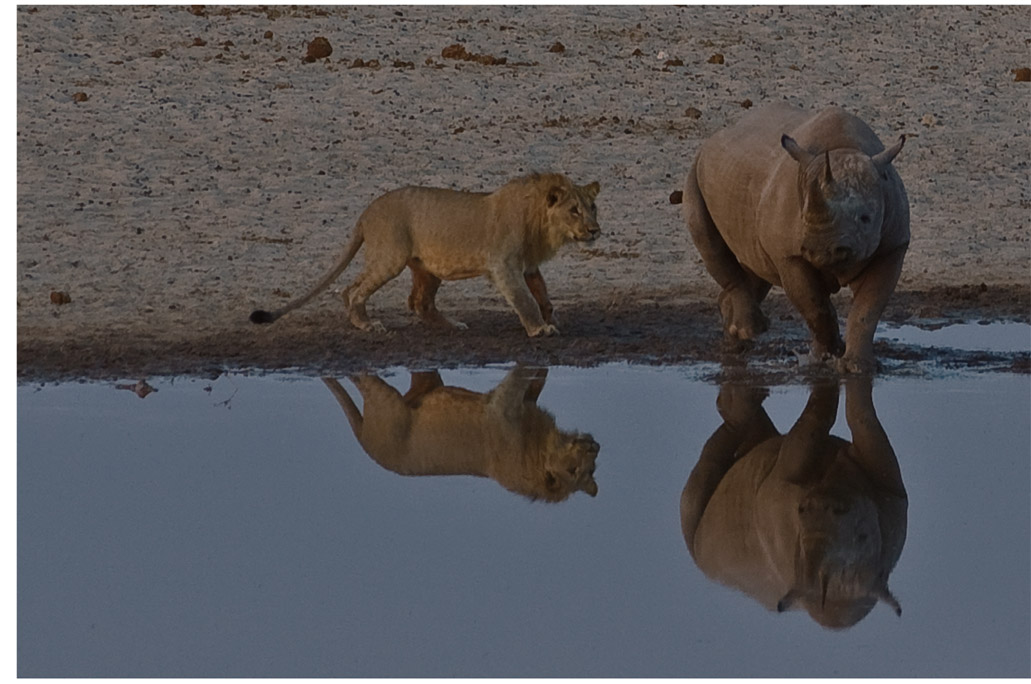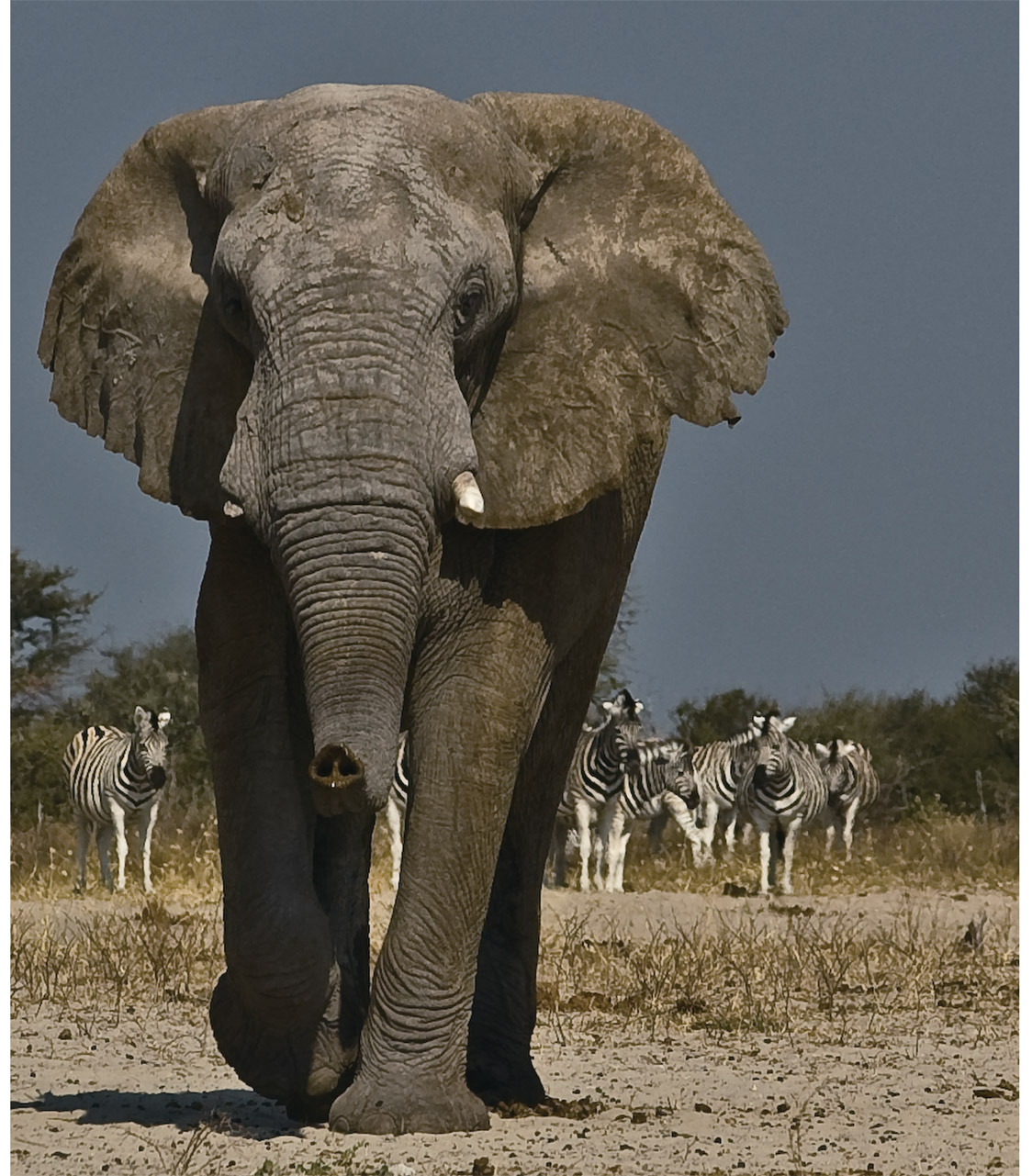

My elephant research began in Etosha National Park, Namibia, in 1992, when my husband, Tim, and I were contracted by the Namibian Ministry of Environment and Tourism and invited to undertake a study of elephants. Although not elephant specialists at the time, we were dedicated field scientists who happened to be in the right place at the right time when the opportunity arose.
Our mission was broad. We were to track movements of elephants within the Okavango River Delta, a system that extends through the Caprivi region of Namibia and into Zambia, Zimbabwe, and Angola.
While tracking the elephants, we were to document every aspect of the animals’ complex social lives, from their demographics to their communications. Finally, we were assigned the task of monitoring any flare-ups in the ongoing conflict between elephants and the local people who had to share the land and its resources. It was a daunting task with a three-year timeline.
Early on in the research, when I was able to spend the winters in Etosha National Park where we could download satellite tracking information from collared elephants, I made my first observations about how elephants communicate. These findings launched my decade-long investigation into the way sound waves travel in elephants’ environments and the ability of elephants to detect both acoustic and seismic information. The advantage of detecting the seismic components of elephant vocalizations was seeing that elephants had the potential to communicate over larger distances than previously thought; it also meant they had an additional channel of communication via signals detected through their feet and trunks. In the late 1990s, while finishing my PhD research at the University of California, Davis, I received a Rotary International Vocational Fellowship that enabled me to return to Namibia to test some of my ideas and to build on my previous research into elephant communication, as well as to search for ways to reduce elephant-human conflict. Around this time, my mentor, Lynette Hart; a geophysicist colleague, Byron Arnason; and I were able to demonstrate that elephant vocalizations indeed propagate in the ground with distinct properties from airborne waves.
After receiving a grant from the National Geographic Society and the U.S. Fish and Wild-life Service as well as a Bio-X Interdisciplinary postdoctoral fellowship at Stanford University, I was able to return to my field site at Mushara waterhole in the early to mid-2000s heading a team of researchers specializing in behavior, geophysics, and geography. Over several seasons, we succeeded in demonstrating that my hypothesis was indeed correct—that not only do low-frequency elephant vocalizations (in the range of 20 hertz, which is below the threshold of human hearing) propagate through the ground, but that other elephants are able to detect and interpret this information at a considerable distance through their feet.
It was during this time—when I had more team members to help me document other aspects of an elephant’s social life—that we started to build an identification system and to develop detailed records of both male and female elephants, their identifying features, their family members and extended associates, as well as their social status within groups. Some of these characters, such as Big Momma and Greg, will be highlighted in the upcoming chapters.
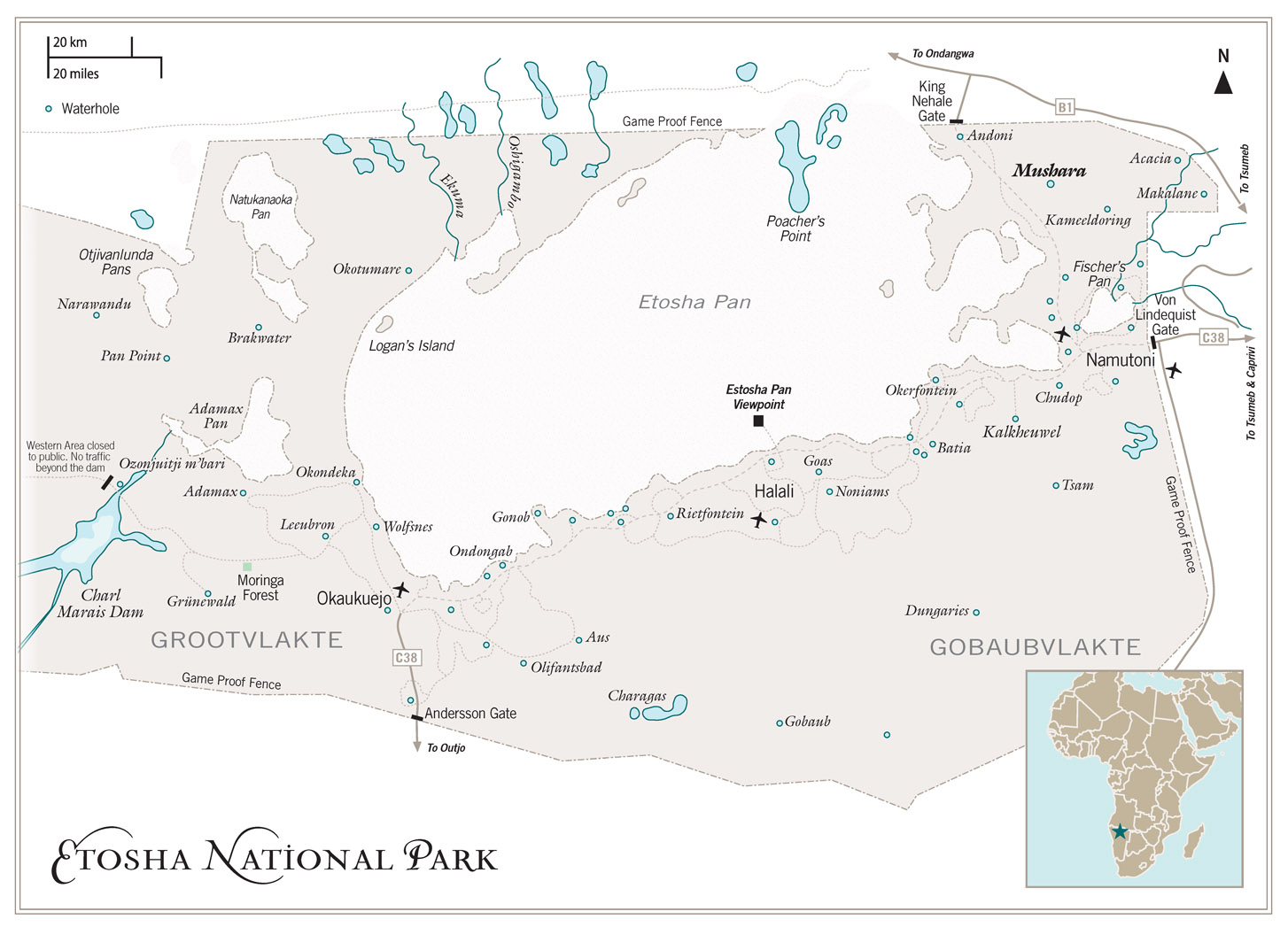
With more observers and a growing record of known elephant individuals, we started to notice the males exhibiting more and more unexpected behaviors. Much of the pioneering work on elephant behavior had been based on long-term studies of herds headed by matriarchs, which consisted of elephant cows of various ages and juveniles and calves of both sexes. The lives of mature bull elephants were relatively poorly understood, at least in terms of what was published.
After many seasons at Mushara, my colleagues and I are now filling in the blanks. For example, bull groups do not appear to be made up of casual associates or single “best buddies,” as previously described, but rather of several members who share a close bond. Some of these bonds persist over years, though we also observe larger groups that form, split up, and re-form, in a phenomenon known to elephant scientists as “fission-fusion” and seen in previous studies of matriarchal herds. These fission-fusion dynamics appear to be influenced by environmental factors, particularly rainfall, which determines the amount of available drinking water.
What we’ve seen is a clear hierarchy that exists among bulls within our study population. Bulls have access to the best drinking spots and the cleanest water according to their social rank. Every visit to the watering hole by a group of bulls is an opportunity for us to mine a rich data set. In order to understand how the hierarchy is structured, we keep score every time a bull successfully displaces another bull from the favored drinking spot at our field site. We document which bulls are displaced and which bulls do the displacing using a Noldus Observer data logger, and we back up the real-time data with video logs. From this data, we are able to construct a hierarchy of bulls that we call the dominance matrix data grid based on scores of these aggressive contests.
In June 1992, after my first night at Okaukuejo waterhole at the main tourist camp in Etosha National Park, my thirst for exploring Africa took on a different form. It turned from desire into a disquieting hunger, a persistent and anxious need for more. Seeing wild elephants in this stark desert context for the first time changed the course of my personal and professional life. There was something about seeing these great ghostly giants in the open desert coming and going silently throughout the night that made me want to understand the rhythm of Africa on a more personal level. I no longer wanted to be a tourist, a bystander in this amazingly intact land that was still so wild and full of life.
Proclaimed a game reserve in 1907 by German governor Frederich von Lindequist, Etosha was originally a bit more than 90,000 square kilometers (nearly 35,000 square miles), incorporating the massive extinct lake Etosha Pan, spanning 4,590 kilometers (2,852 miles). The size of the park fluctuated over the next century, the current area covering just over 22,000 square kilometers (8,494 square miles) and hosting 114 mammal species—such as elephants, rhinos, giraffe, zebra, wildebeest, kudu, lions, and leopards—and 340 bird species, over 100 reptiles, 16 amphibians, and one fish species.
The park is relatively flat except for rocky escarpments in the west that are closed to tourism. Much of the rest of the park ranges in habitat from vast grass plains and shrubs surrounding the pan to deciduous trees, consisting of mopane trees and what is called mixed bushveld. The bushveld ranges from dense bush to open tree savannahs (including many acacia species) to the sandy environment of the northeast called the tree sandveld, where tree species tend to grow taller in the deep sand. Our field site, Mushara, is named after the terminalia species predominant in the area.
The Mushara field camp is a temporary, seasonal 30 by 30-foot canvas enclosure surrounding a three-story, 20-foot-high permanent tower positioned 240 feet from the waterhole. The entire perimeter of the camp is enclosed by an electric fence.
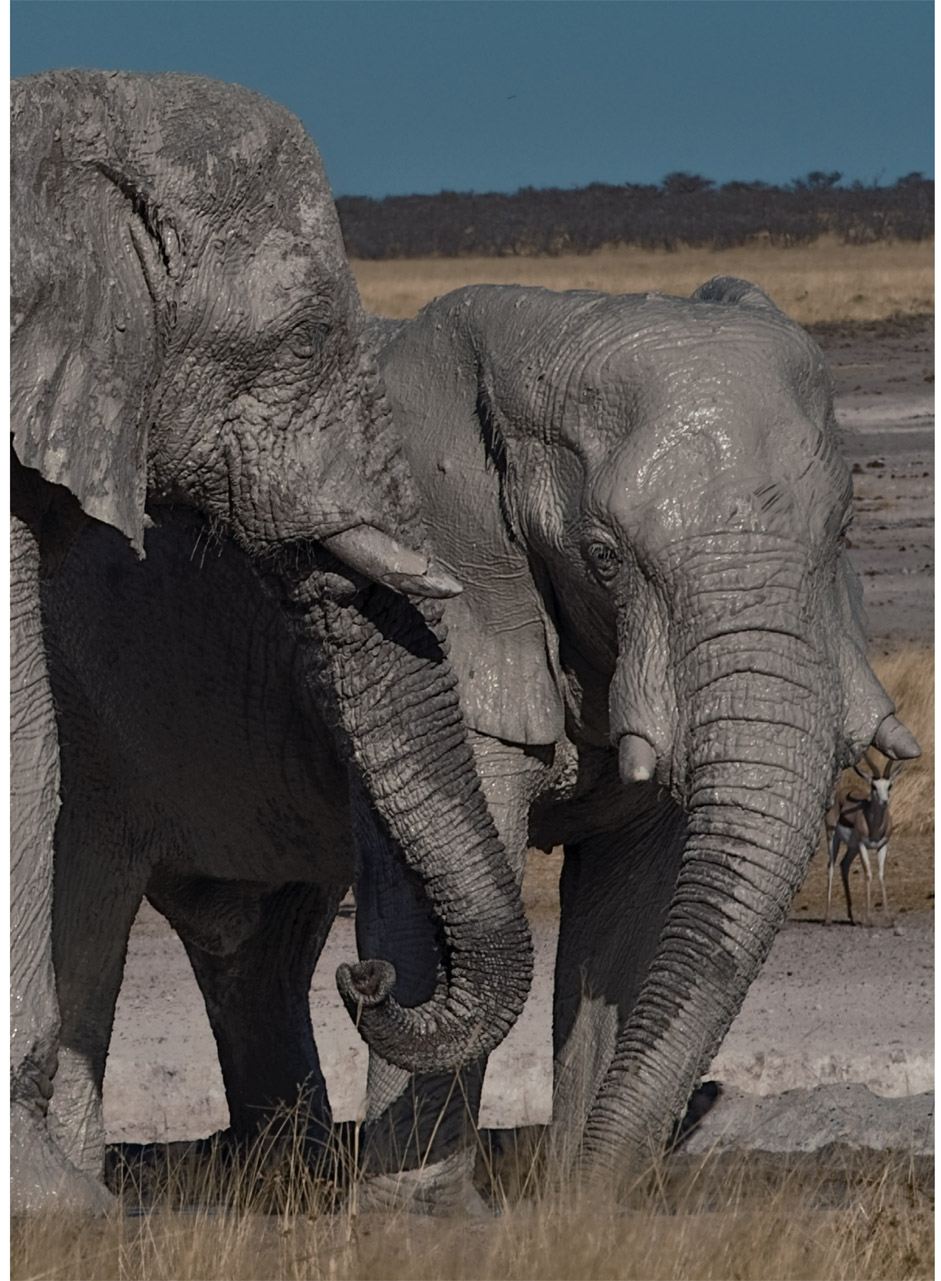
Etosha Pan is an expansive dry lake bed that sometimes floods in the wet season. Over the course of our studies, 2004, 2005, and 2007 were dry years (around 300 mm of rain) and 2006, 2008, and 2009 were relatively wet years (more than 500 mm of rain). We found that the difference in rainfall between years correlated with male elephant group sizes—the drier years having much bigger group sizes than the wetter years. It appears that the environment has an influence on sociality in this region, which may suggest that elephants have a slightly different social organization in arid environments than they do in environments with perennial rivers and higher rainfall. If this is true, then it is all the more important to conduct long-term research on elephant social structure in different environments to understand the variation in their social dynamics and complexity across their range.
Every year from 2002 to the present, we have returned to Mushara during the dry months of June and July, when elephants come to the waterholes in great numbers. At the height of the dry season, drinking water is scarce, and the water at Mushara draws elephants and other wildlife. During this time, we have been monitoring bonded male groups to determine their social structure and to find out what holds these groups together.
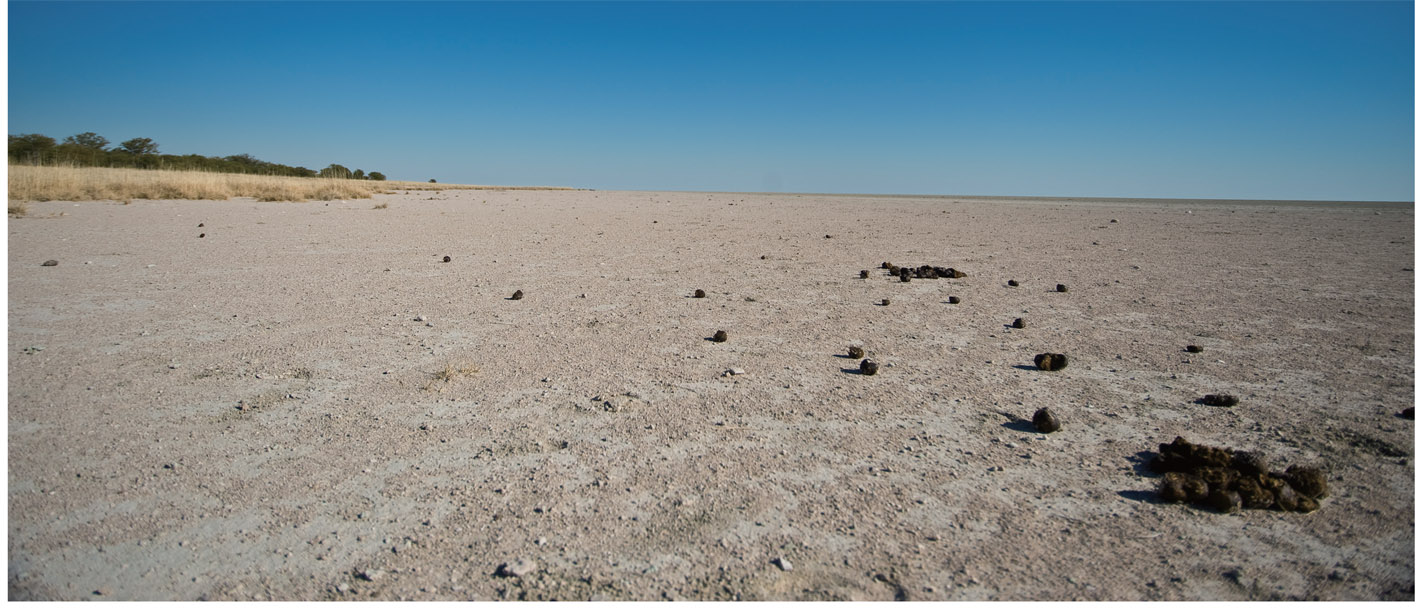
Etosha pan floods seasonally and is normally dry in the dry season.
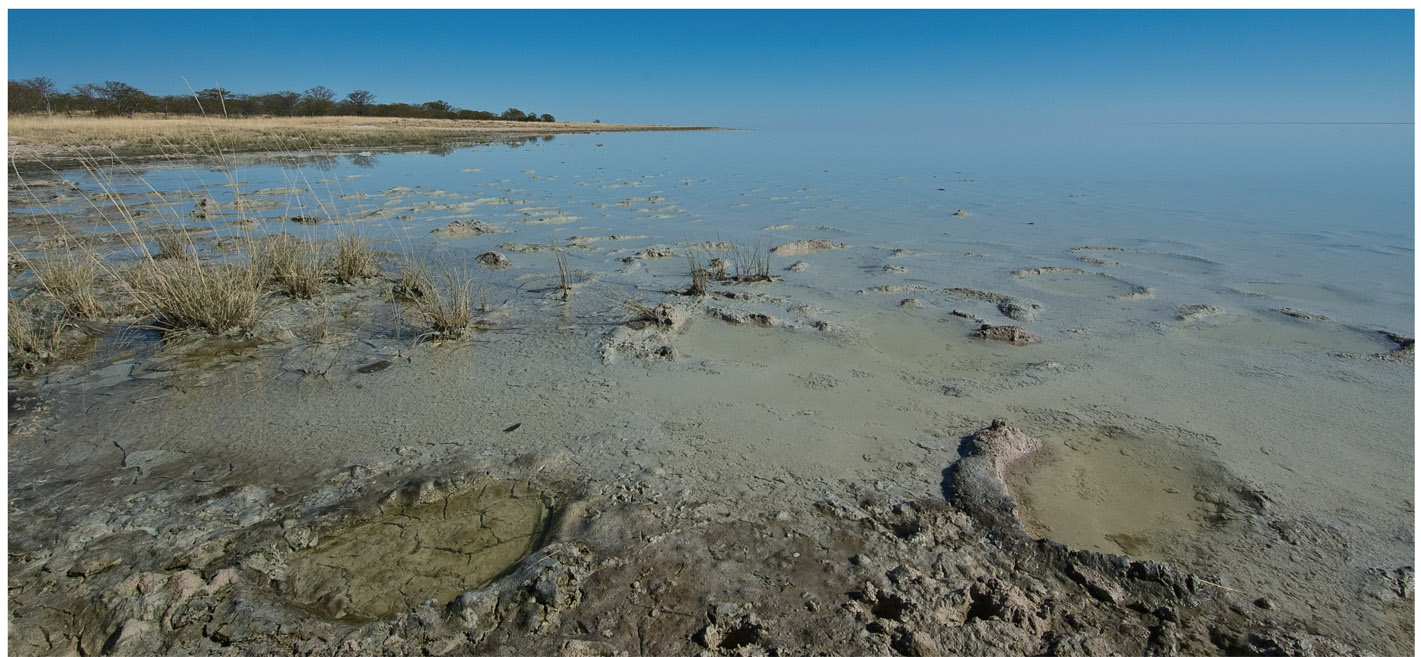
The pan flooded in 2006 after a fifty-year-high rainfall and remained full in the dry season.
The base camp has a kitchen, dining area, pantry, two-person field tent, outhouse and solar shower, as well as an elephant dung processing facility at the base of the tower, a changing area, and an exercise space. The electrical needs of the research and camp operation are run off a solar panel that charges a bank of 12-volt batteries.
The first platform level of the tower holds three two-person tents, and the second level contains the research operation, where elephant identifications are made, behavior data are collected, fecal samples are mapped, and behavior sessions are recorded with a video camera. The third level of the tower has an additional two-person tent, a year-round operated remote camera trap, and it is where the playback and acoustic experiments are conducted and vocalizations are recorded.
In addition to the research area on the second floor of the tower, outside the electrical fence there is a small seven-by-seven-foot cement bunker sixty feet from the waterhole that allows for closer observations and elephant identification work. Just to the right of the bunker, seismic playback equipment is buried in the ground and audio equipment is hidden underneath a pile of thorny branches, surrounded by calcrete rocks to protect the equipment from curious elephants and lions. All of this equipment is controlled remotely from the tower with wires buried between the tower and the branch pile.
If you don’t mind roughing it, our field camp at Mushara is a five-star animal experience within an exclusive resort. By day, you can enjoy breathtaking views of an animal Garden of Eden, with wildlife enough to fill several arks. The crowned and blacksmith plovers patrol the shores, making the pan seem like a vast lake, harkening back to prehistoric times when Etosha Pan was a permanent lake.
On any given day, breakfast is served at 8 a.m. with enough time for students to finish preparing dung samples from the previous day, and perhaps a postcard or two before the elephant bulls tend to stroll in at about 10:30 a.m. On busy bull days, visits tend to occur on and off throughout the day, with the longer sessions lasting up to several hours and sometimes involving more than twenty bulls. On less busy days, there may only be two to three bulls coming in to drink over the course of the day.
In and around these elephant data collection sessions, team members rotate through a roster of kitchen and camp duties, and those on lunch duty juggle between their research responsibilities and preparing food for the team. Lunch on the research deck is always a treat, whether we are entertained by an ostrich mating ritual, a host of vultures coming in to drink after dining on the remains of the local lion pride’s kill from the night before, or a group of bulls cooling off with a mud bath.
Sometime after 4 p.m., if there are any family groups in the area, they start to arrive for a drink. If we are lucky enough, they arrive with enough remaining afternoon light for a few team members to get into the bunker for close-up photo identifications, while the rest of the team documents the visit with video, scoring dominance interactions within and between family groups.
Over the years, we have compiled a detailed identification book cataloging each elephant and its distinctive features, such as ear tears and holes, tail hair pattern, tusk shape, and overall size. This allows us to identify individuals and keep track of changes of any features over time, such as a broken tusk, a new tear in the ear, missing tail hair, or the arrival of a new baby, and whether and for how long a resident bull or matriarch does not show up from season to season.
We keep a database of behaviors and group dynamics using a Noldus Observer data logger and video logs to document all interactions in real time while elephants visit the waterhole. Our other work at Mushara has us keeping track of the female-headed herds. We record new births as well as the departures of the coming-of-age bulls, and note how dominance within and between family groups appears to shape certain interactions. As with the bulls, much of the drama within and between herds centers on access to water.
At the same time, we collect dung samples from these events in order to analyze levels of stress hormones, specifically cortisol, throughout the field season. Fecal samples from bulls are tested for testosterone levels during aggressive interactions or to confirm when a bull is in the hormonal state of musth—a period similar to rutting in antelope, when a male becomes more reproductively active. Since it takes twenty-four hours for relevant hormones to show up in the dung, the potential impact of behaviors witnessed on one day will only show up in fecal samples collected on the following day. Collecting elephant dung has also allowed us to see whether (and how) bonded bulls are related genetically, which we hope will result in some interesting findings. We also use equipment to make acoustic and seismic recordings of elephant vocalizations. Studying elephants’ reactions to the recordings (known as a playback study) has been an ongoing focus of the research.
Aside from elephants, many other animals rely on Mushara waterhole at the northeast corner of the park, as it is one of the very few places to drink in the dry season. Zebra, giraffe, oryx, springbok, eland, and kudu rely on Mushara, as do their predators—the lions, jackals, and hyenas.
It can be a little nerve-racking to live on the lion’s dinner plate over the course of the field season, but we conduct our research activities with caution and are always on the lookout for a lion on the prowl. Most of the time their antics are quite entertaining, whether they be the ardent efforts of a lioness to get her suitor to perform yet one more time (apparently, as many as a thousand copulations are necessary for ovulation to occur), making for a very noisy night, or the failed attempts of Bobtail’s subadult sons at hunting.
Although Mushara can be quite chaotic with so many different species vying for a position at the water, some sunsets are so quiet that all that can be heard are the beating wings and chortling of the double-banded sand grouse while a few lone gemsbok take an evening drink.
After dark, Mushara transforms. The air is crisp, and nocturnal sounds announce the evening, starting with a jackal chorus. Depending on the phase of the moon, the landscape is glowing in the moonlight or the black sky is lit up with a brilliant path of stars.
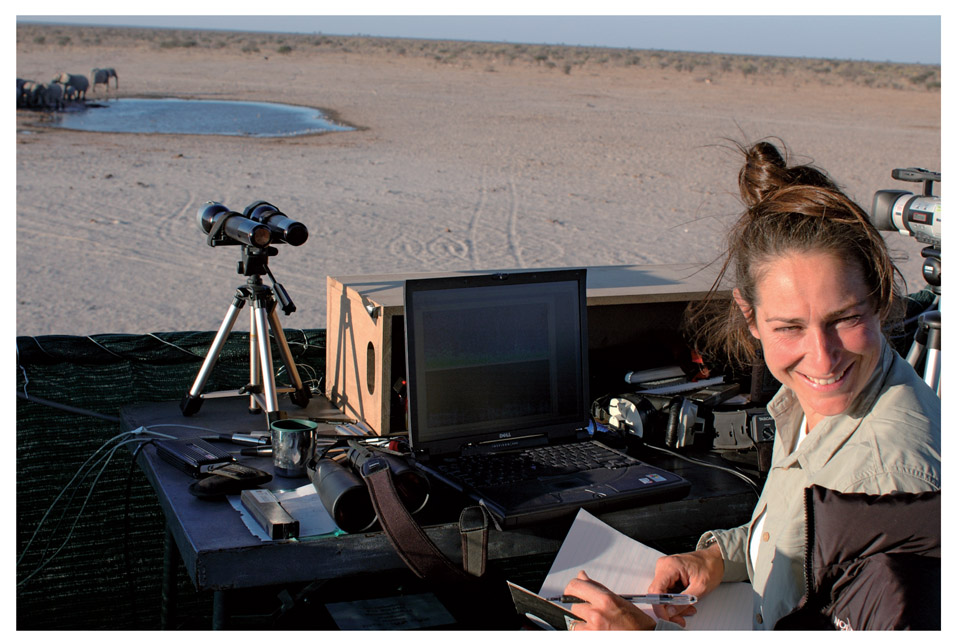
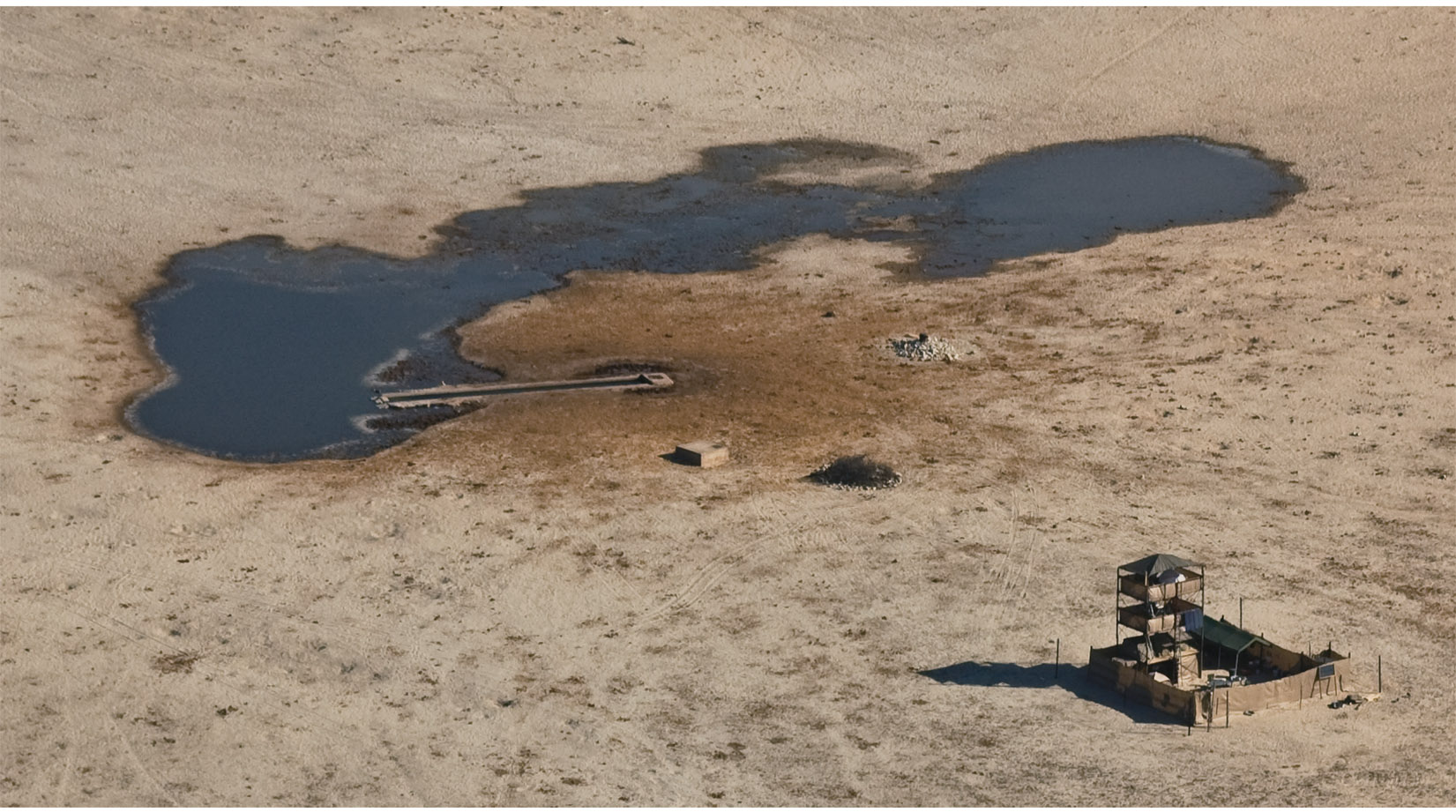
Aerial view of Mushara tower and research camp. Mushara waterhole is a natural spring; the flow is controlled by a ball valve. The spring flows into a trough and then spills over into a shallow clay depression, or pan. The head of the trough holds the freshest water, so access to this spot is often coveted by dominant elephants. The square cement bunker to the right of the waterhole allows us a close (and safe) vantage for observations and ID work.
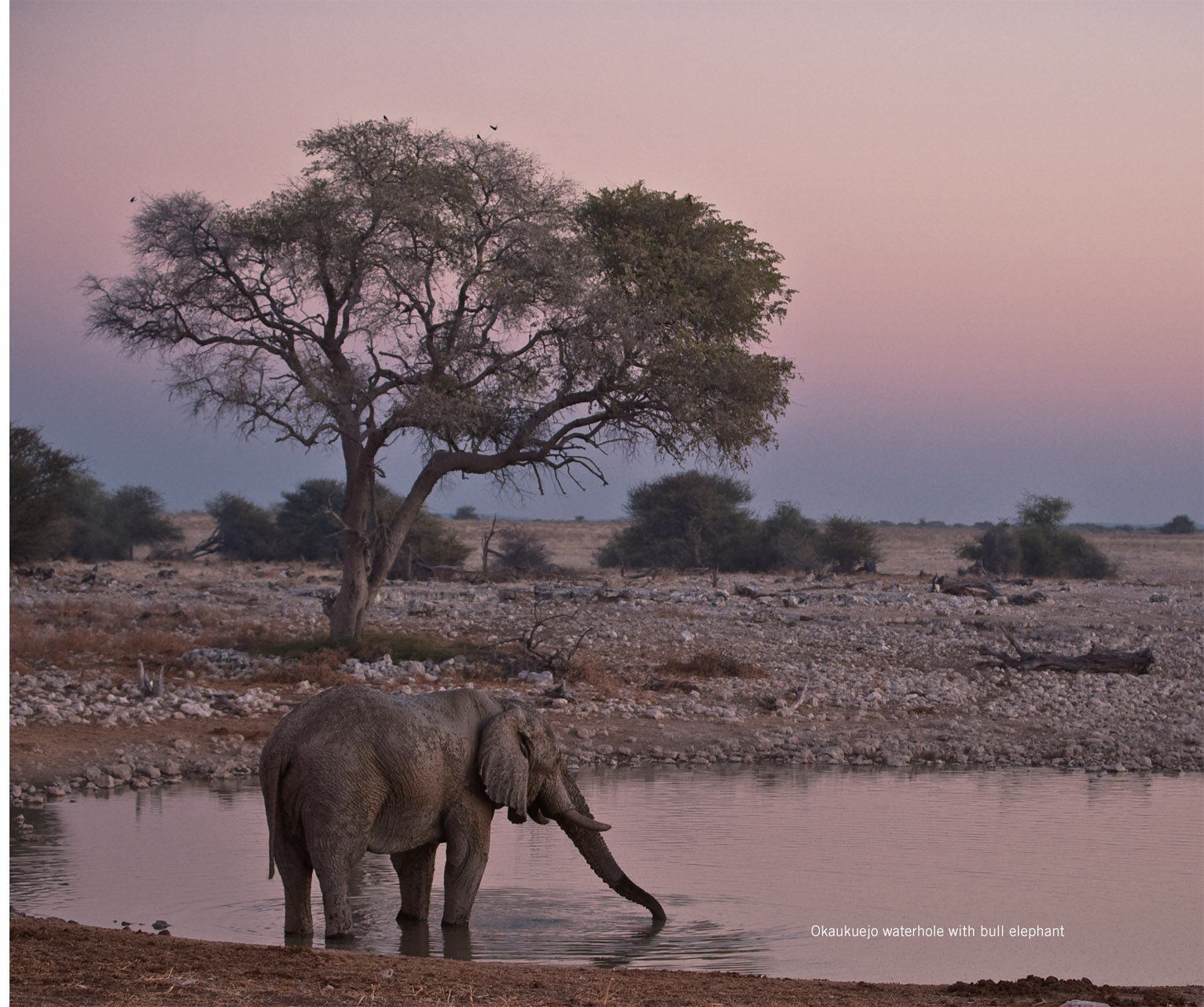
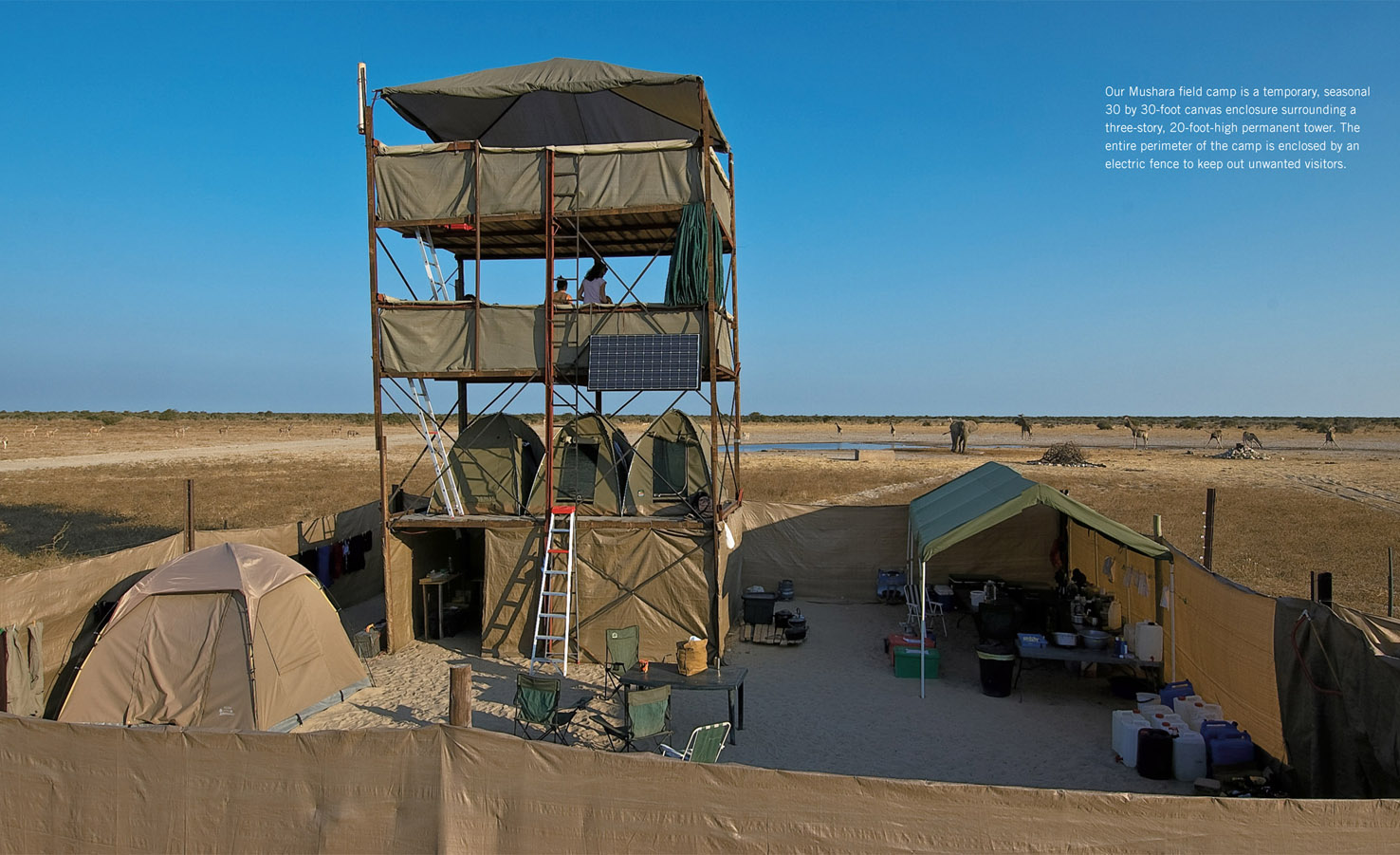
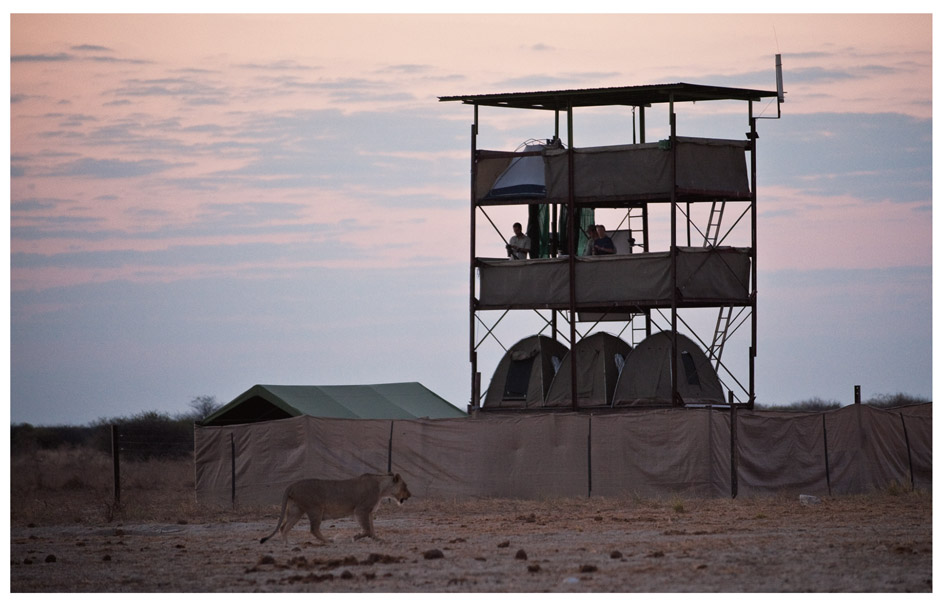
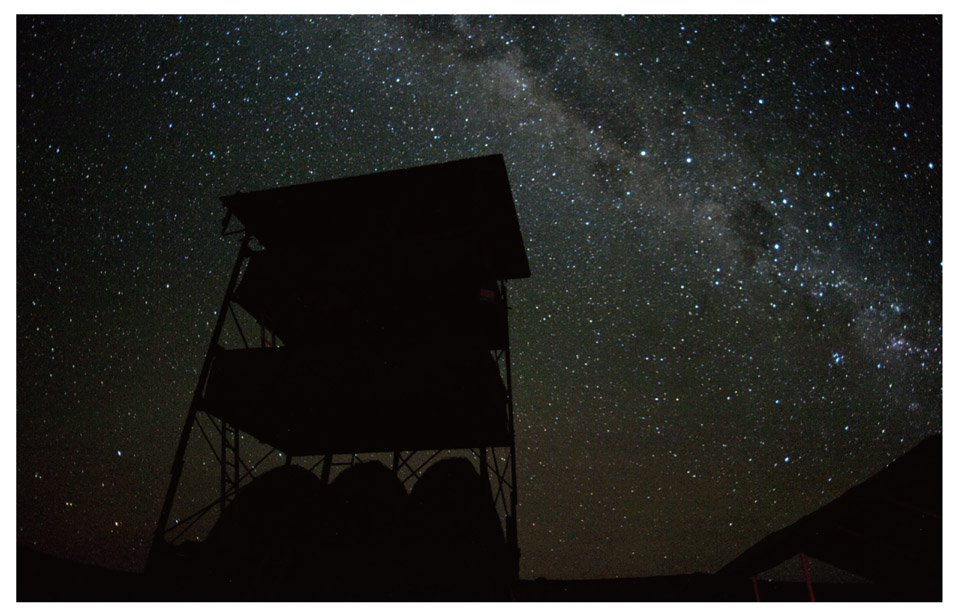

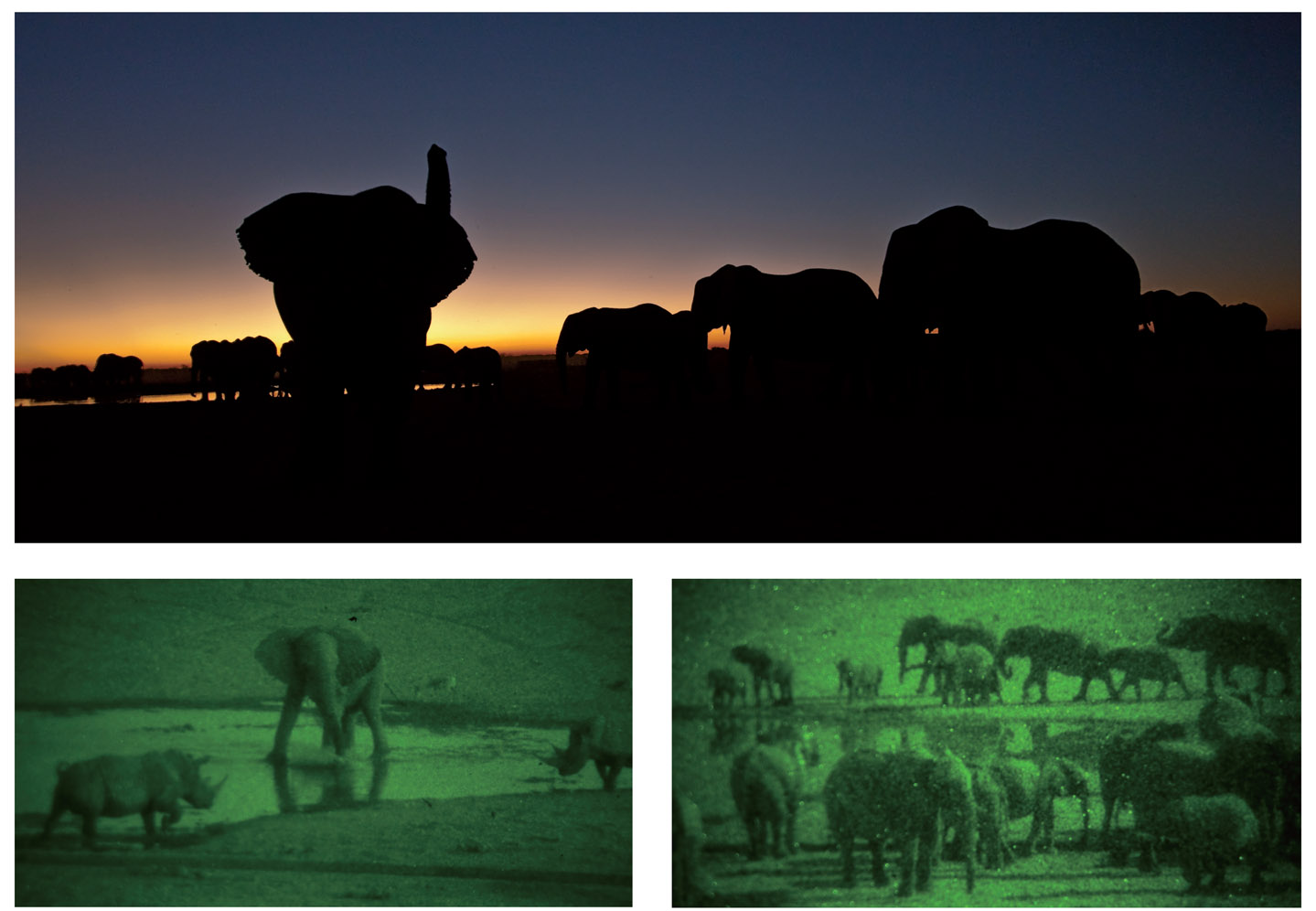
The field team observes elephant activity at the waterhole with night vision equipment. At the same time, we use red light headlamps (facing page, bottom left) to conduct behavioral research with minimal disturbance to the animals.
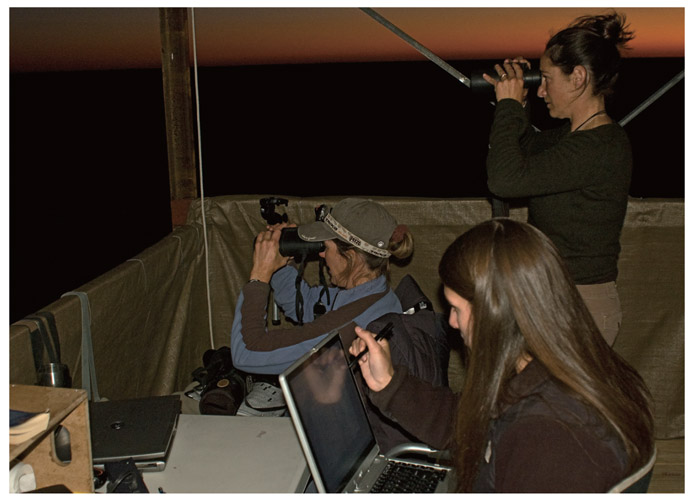
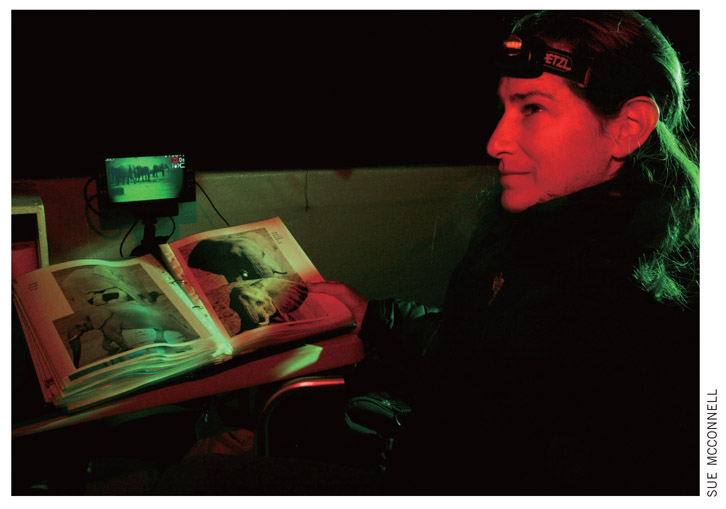

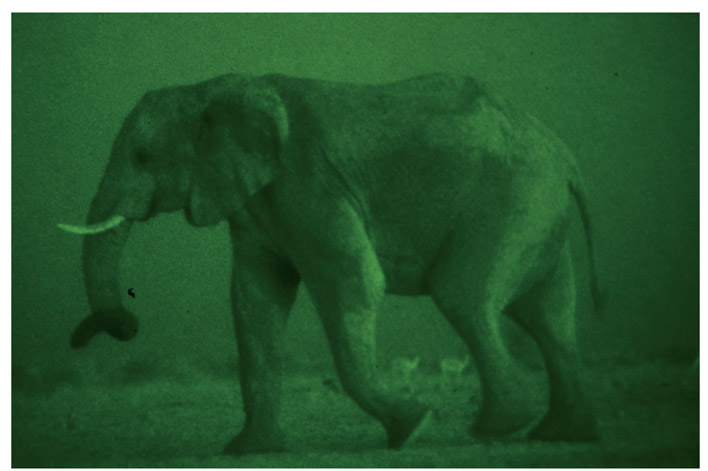
Although the nighttime activity can get very exciting with a lot of family groups visiting, it can also be hard on the team after a whole day of watching the bulls and with the temperature dropping as the hours go by. Everyone looks forward to a good night’s sleep in a warm sleeping bag after these nights.
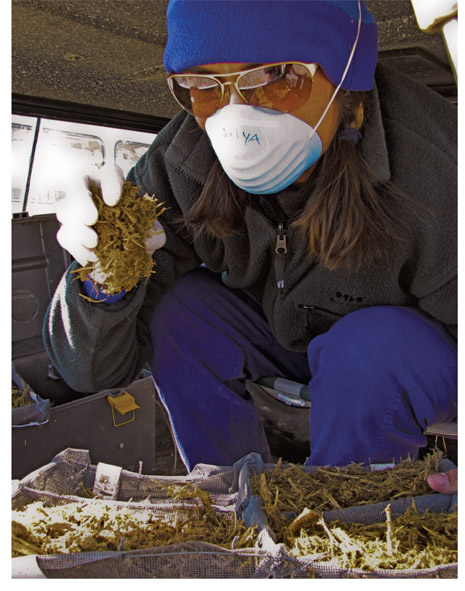
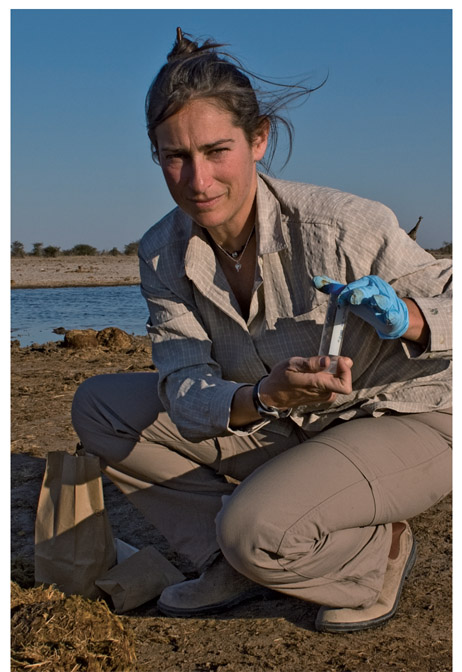
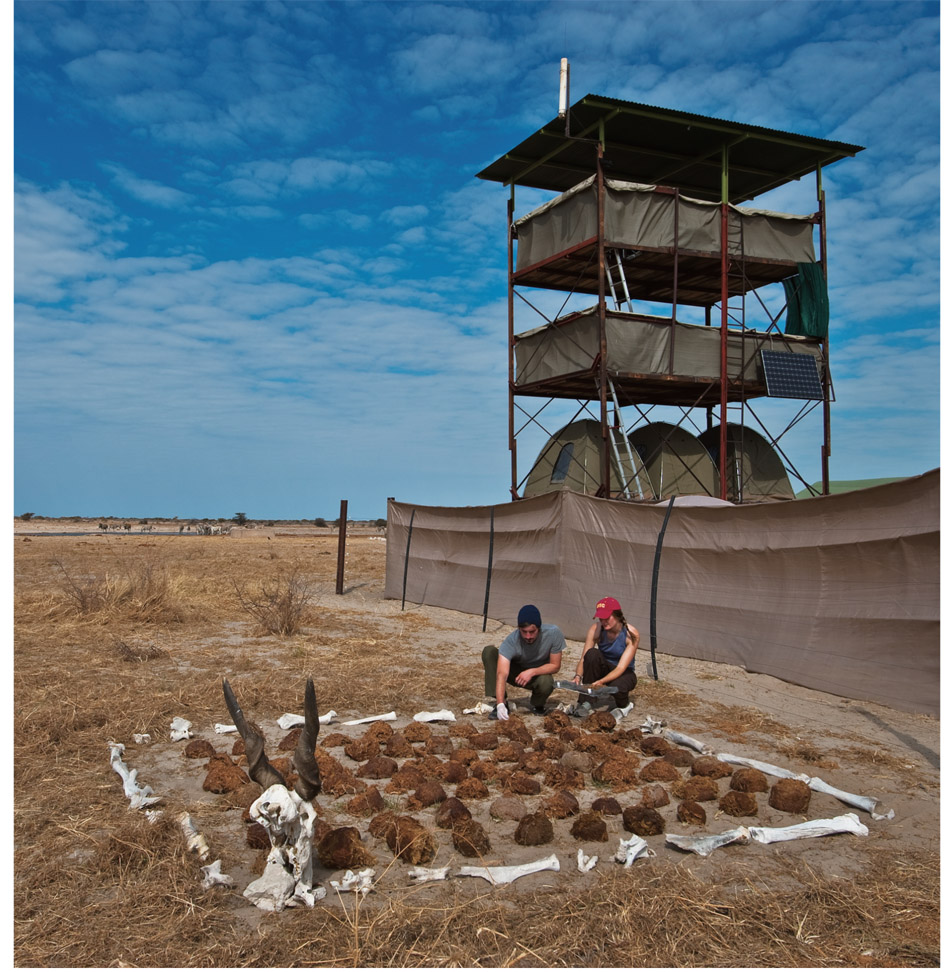
After collection, fecal samples for hormone analysis are dried for twenty-four hours in individual baskets within our solar-powered dung dryer. Each sample is then sifted and fecal powder is stored for later radioimmunoassay treatment to extract hormones. Here (top left), field assistant Tanya Meyer prepares to sift a sample in the least windy place she can find—which happens to be in the back of the truck. Genetic information on certain individuals is obtained by collecting fecal samples in which cells from the colon have sloughed off and DNA can be extracted (bottom left). Students Andrew Wicklund and Mary Thurber (above) study how hormones from known fecal samples degrade over time.
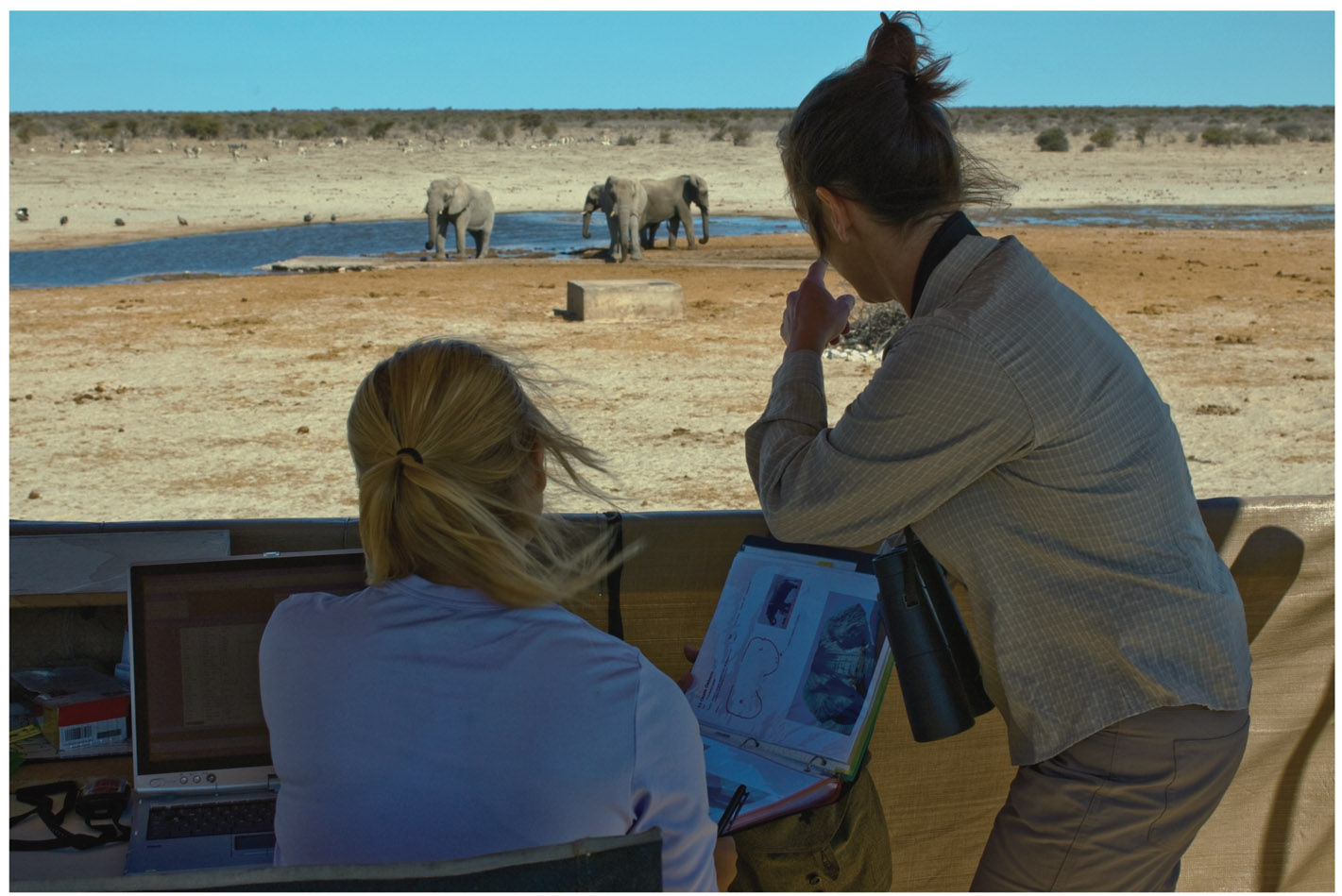
In addition to the research area on the second floor of the tower at base camp, there is a small cement bunker (shown in the foreground here) that allows for closer observation of the elephants. In the safety of the tower, I show my student, Mindi Summers, how to identify the bulls at the waterhole using a book which records ear tears, tail hair patterns and other defining characteristics. Meanwhile, Mindi has the behavior datalogger on a tablet PC open, ready to enter behaviors that I call out to her.
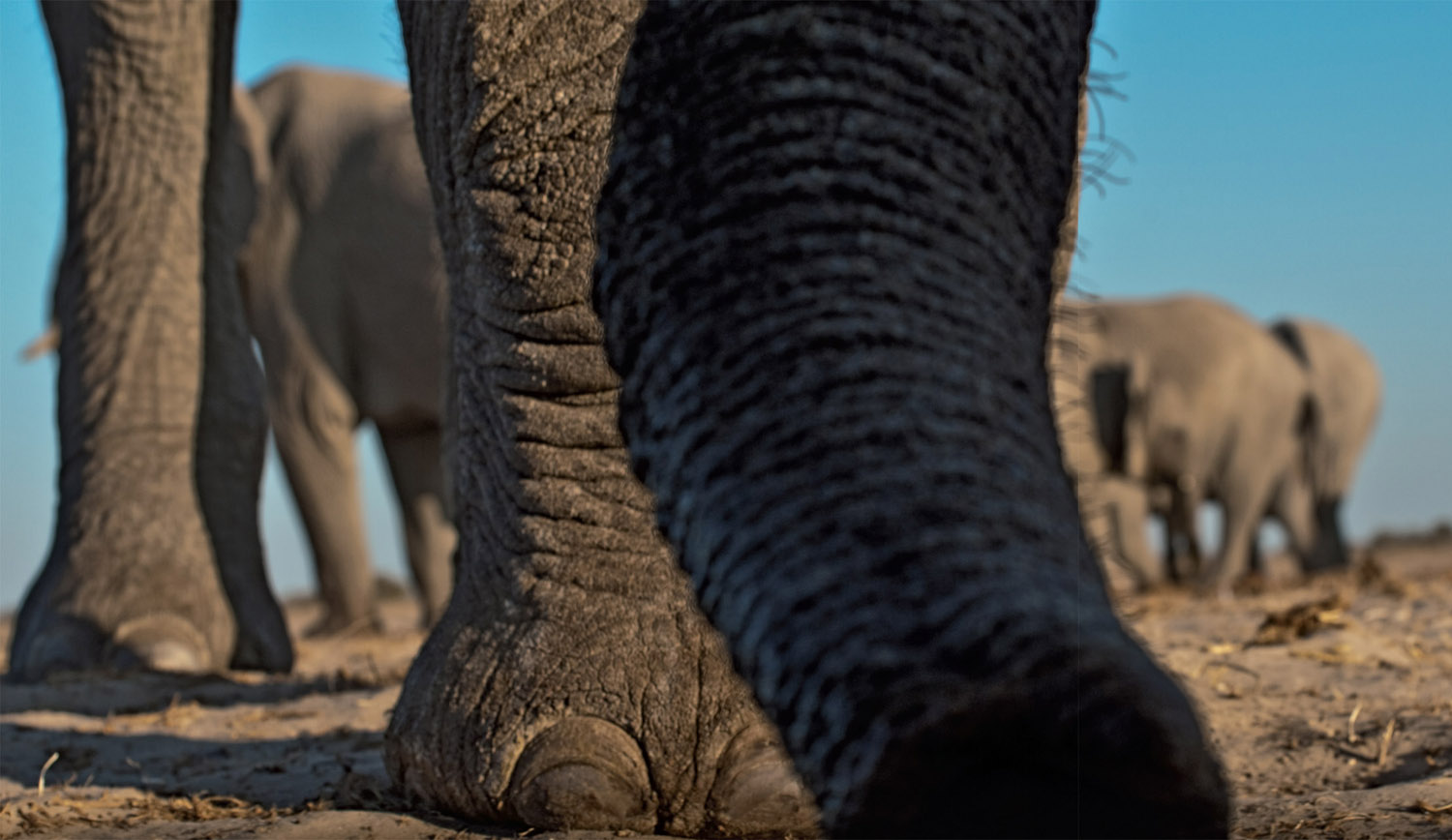
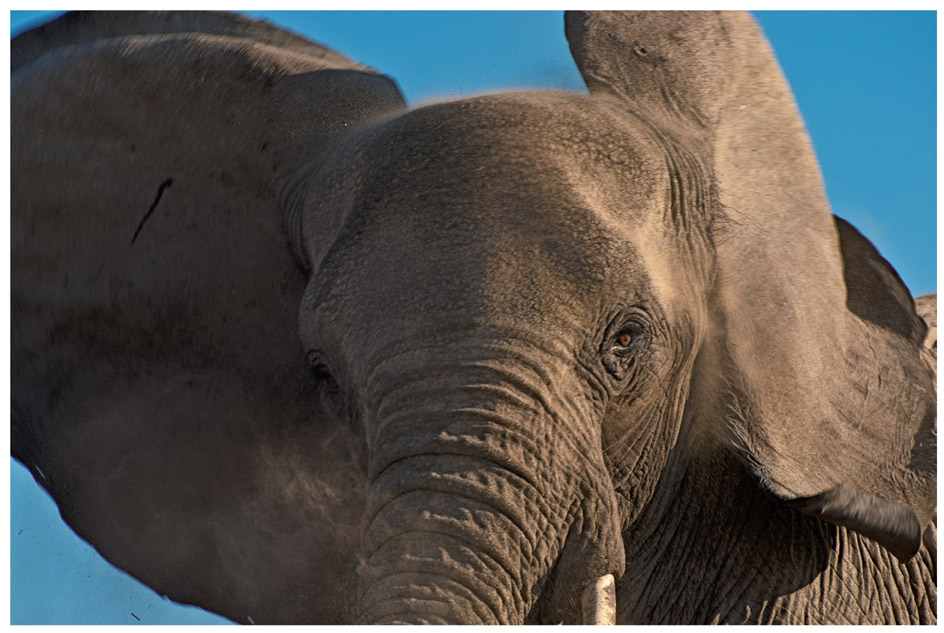
Inside the bunker, I have had some hairy moments alone when a long, wrinkly trunk has suddenly appeared in the viewing slit. On more than one occasion, a dripping proboscis has practically knocked over my tripod and assaulted me with heavy breathing and bad breath, like a giant worm testing, assessing what lies within that cement box. I’ve had to stretch myself well out of the way lest the brain attached to this brawn were to decide to do something more than just investigate. There is also a moment of morbid fascination, time standing still, as an elephant comes full steam ahead in a charge, with no sign of stopping. Females are more likely to follow through with a charge than males, because they often have babies to protect. Fortunately, in this case I was able to retreat into the concrete bunker and let this wary young female, Panga (above), drink in peace with her family.
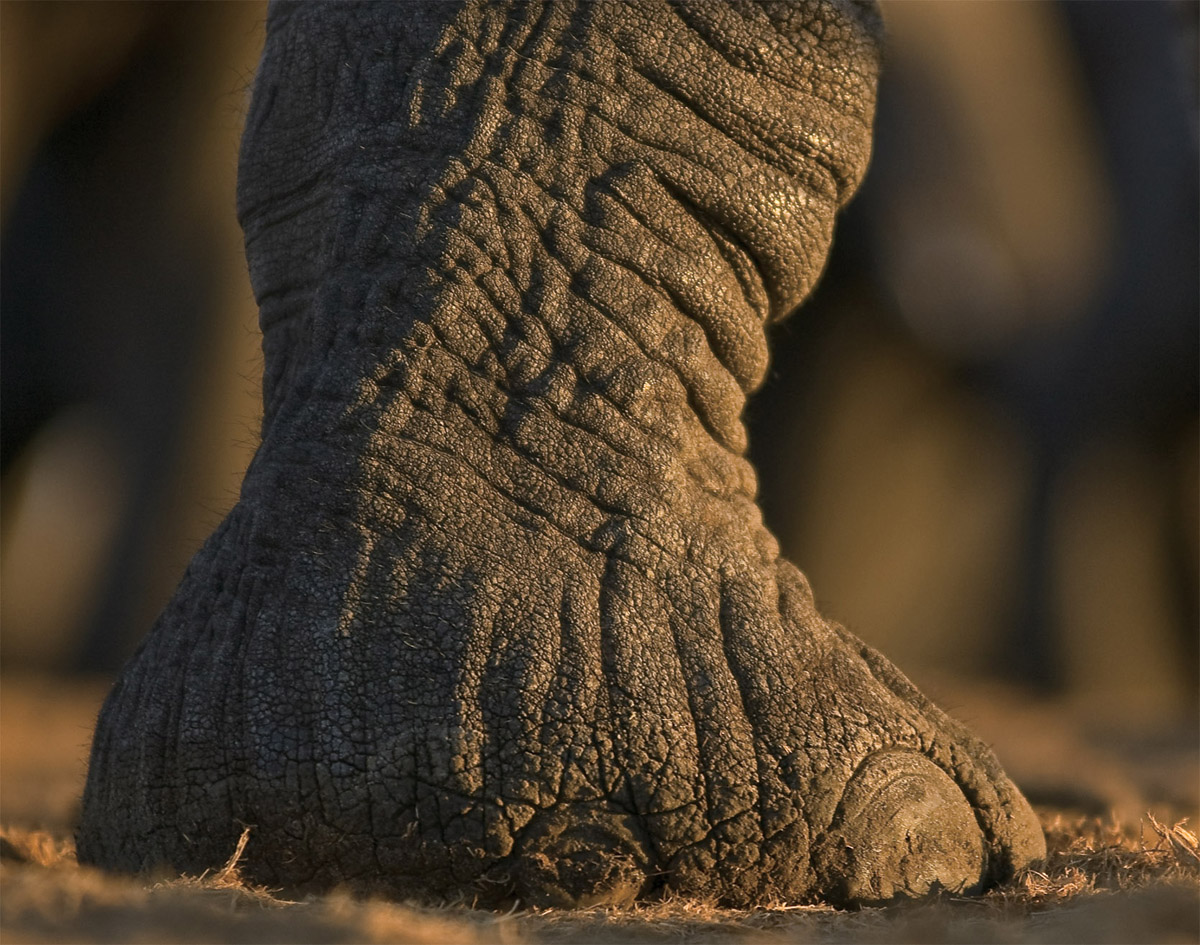
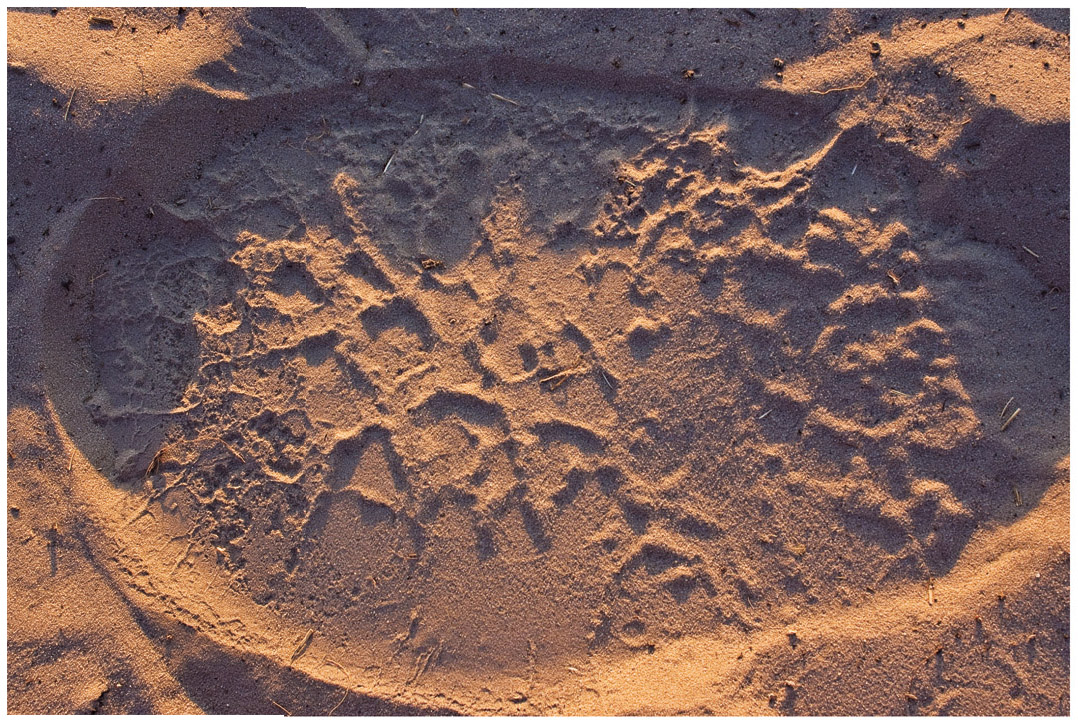
Because hind foot length scales with shoulder height and age, my graduate student (and general curator of the Oakland Zoo), Colleen Kinzley, and I measure as many of the known male footprints as we can so that we can get a better age estimate than just measuring shoulder height (which we do with a laser altimeter back in the tower).
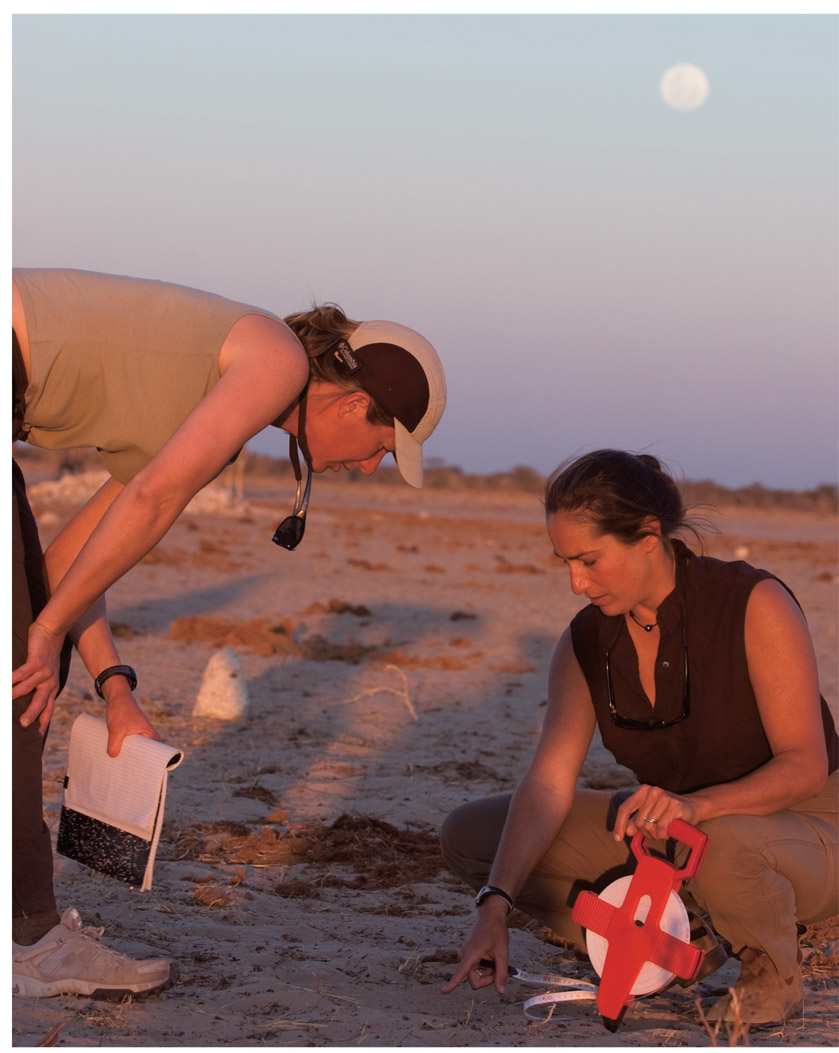
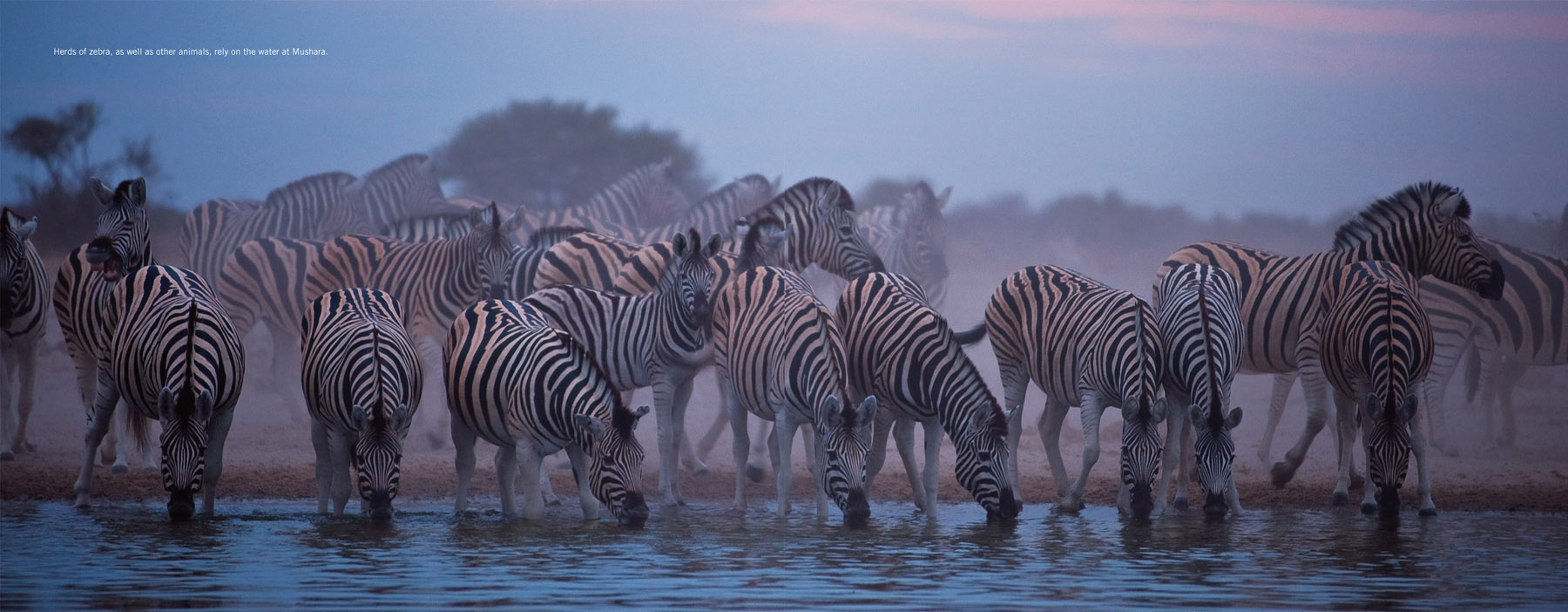
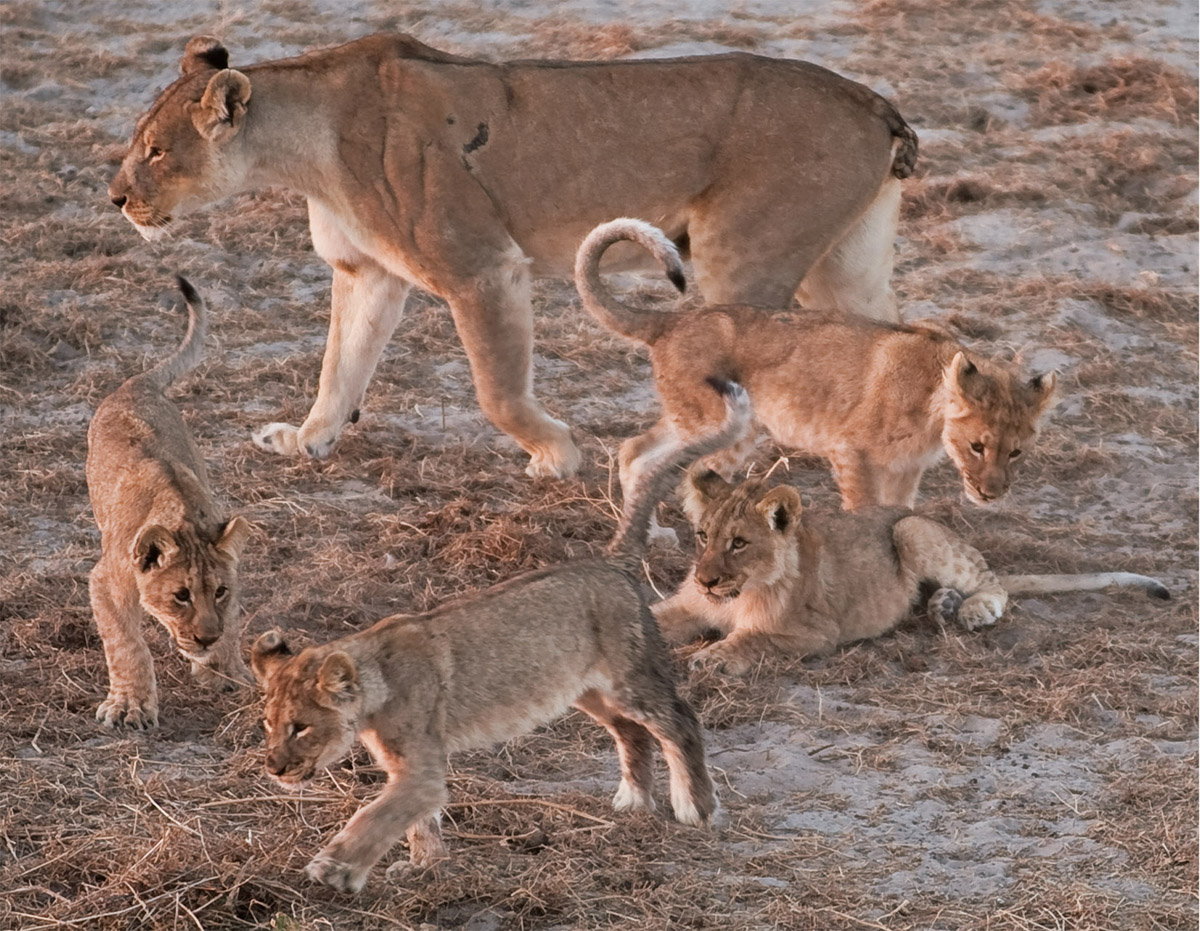
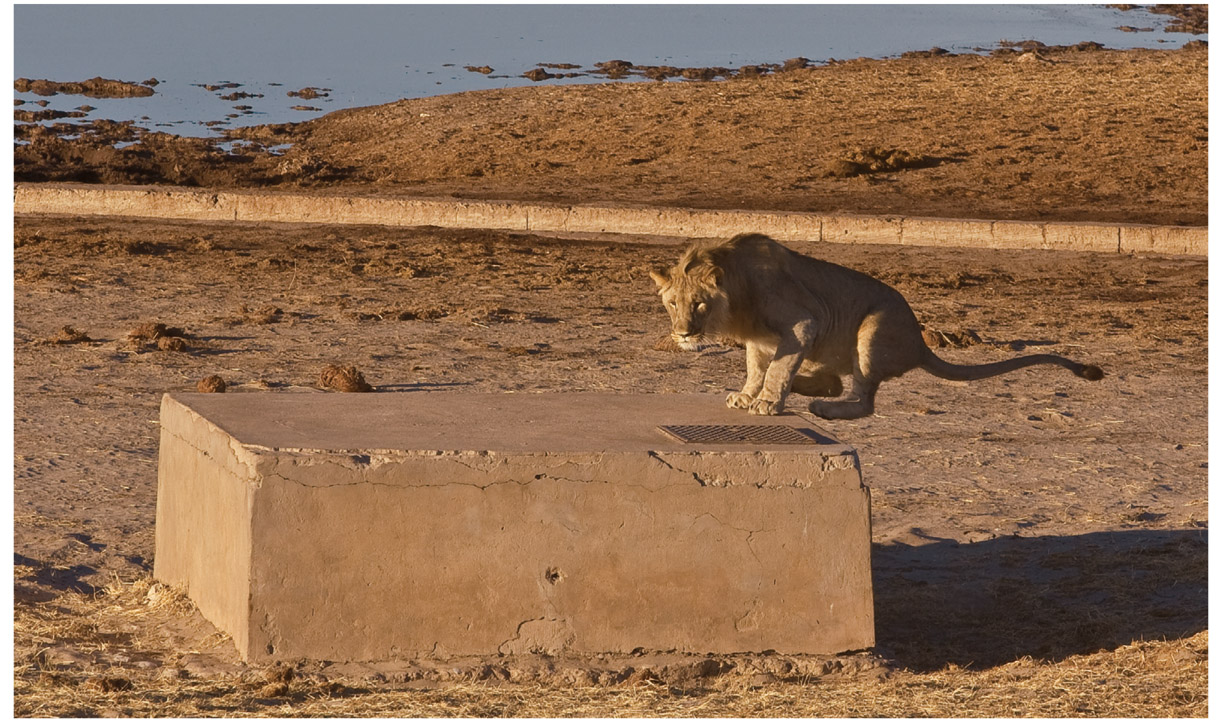
Bobtail and her four cubs.
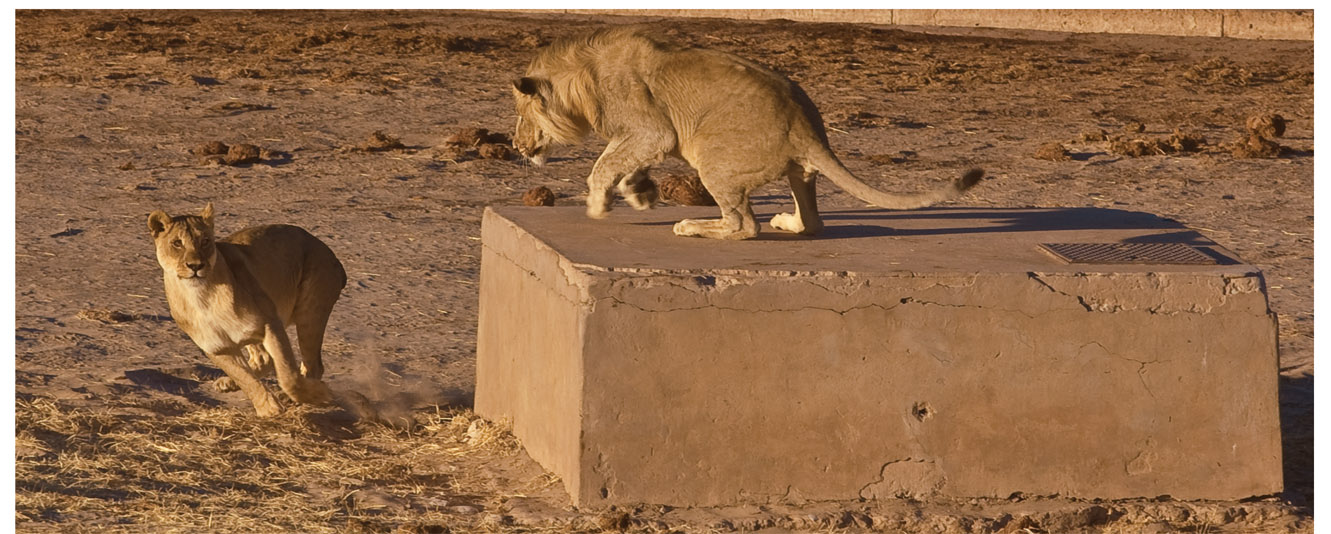
It can be a little nerve-racking to live on the lion’s dinner plate, but we conduct our research activities with caution and are always on the lookout for a lion on the prowl. Now that Bobtail’s sons are growing up, some of their antics can be quite entertaining to watch.
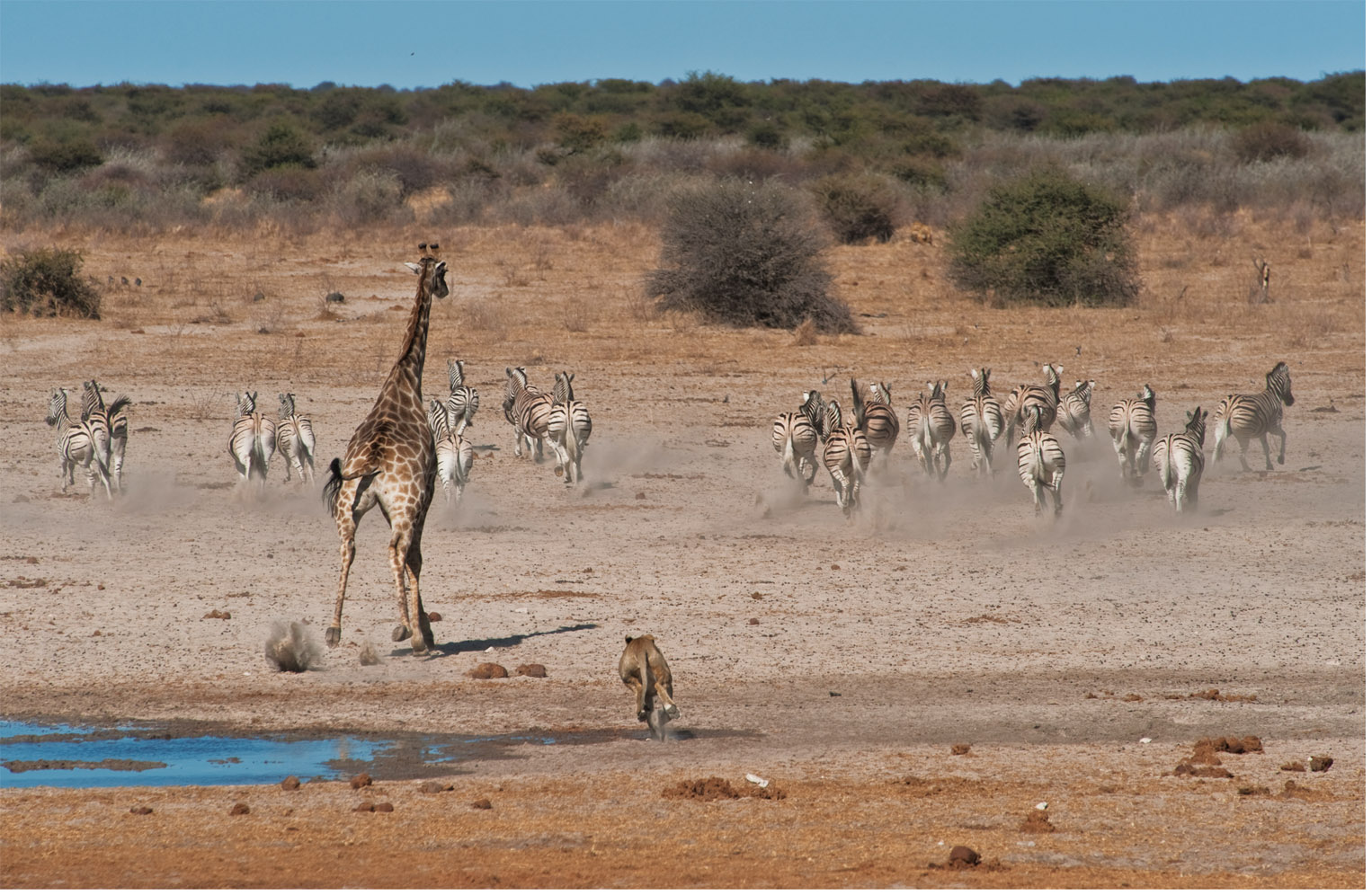
As the lion is the primary predator of elephants, female elephants are usually very intolerant of lions’ presence at a waterhole, particularly if there are new calves in the group. Such intolerance is not usually demonstrated by adult bull elephants, who rarely acknowledge the presence of lions at a waterhole unless they are in their path, in which case the bull will simply toss his trunk to get rid of the menace. Every so often, a younger bull will respond more aggressively, as if he remembers what it was like to live inside the family that is plagued by lions on the prowl; perhaps he may even have been stalked by a brave pride when distancing himself from his family. In the photo sequence on pages 27–29, Keith catches Bobtail’s subadult sons off guard and charges them quite aggressively, kicking up sand with his foot, shaking his head in warning, and tossing his trunk to hurry them on their way, without hesitation.
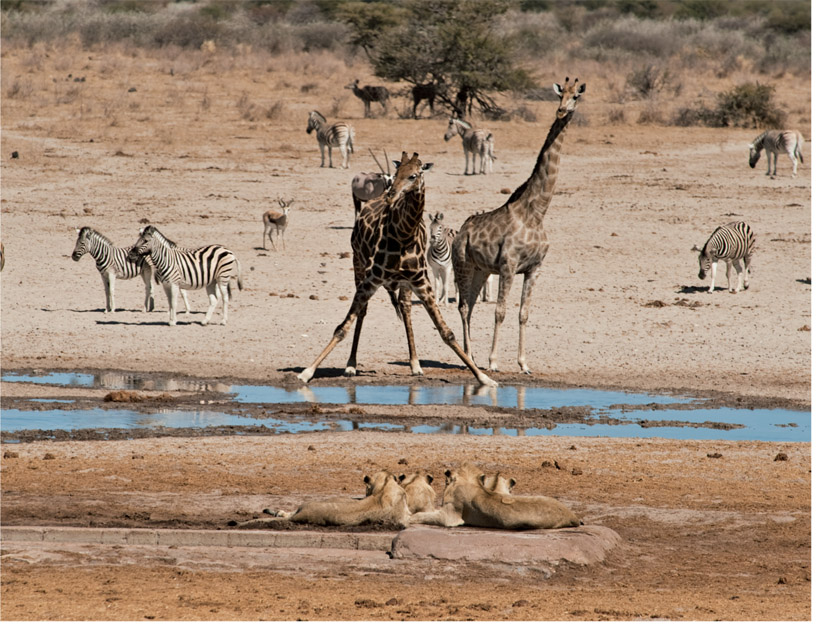
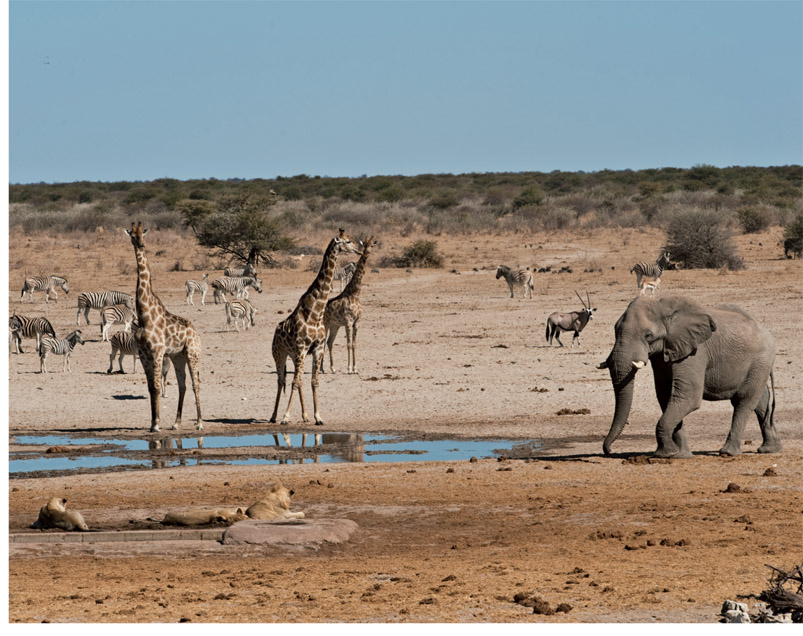
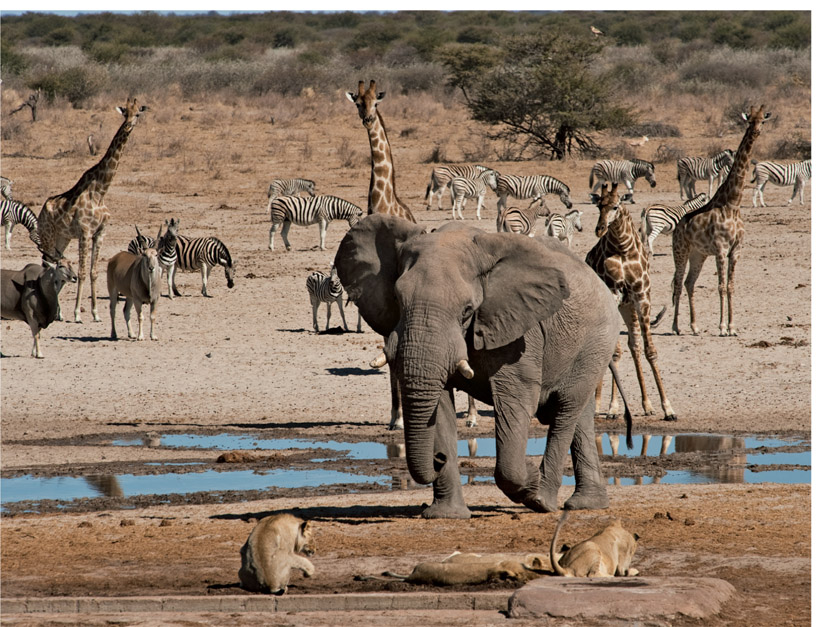
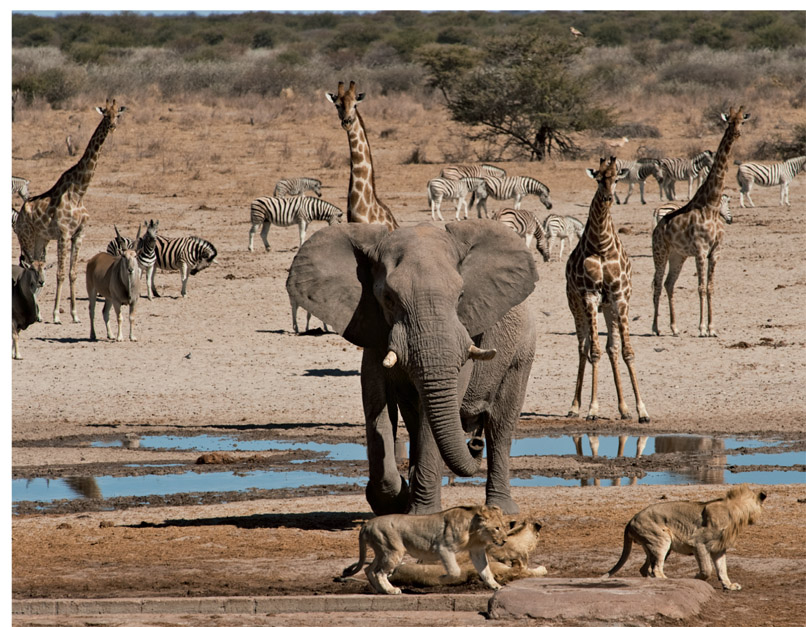
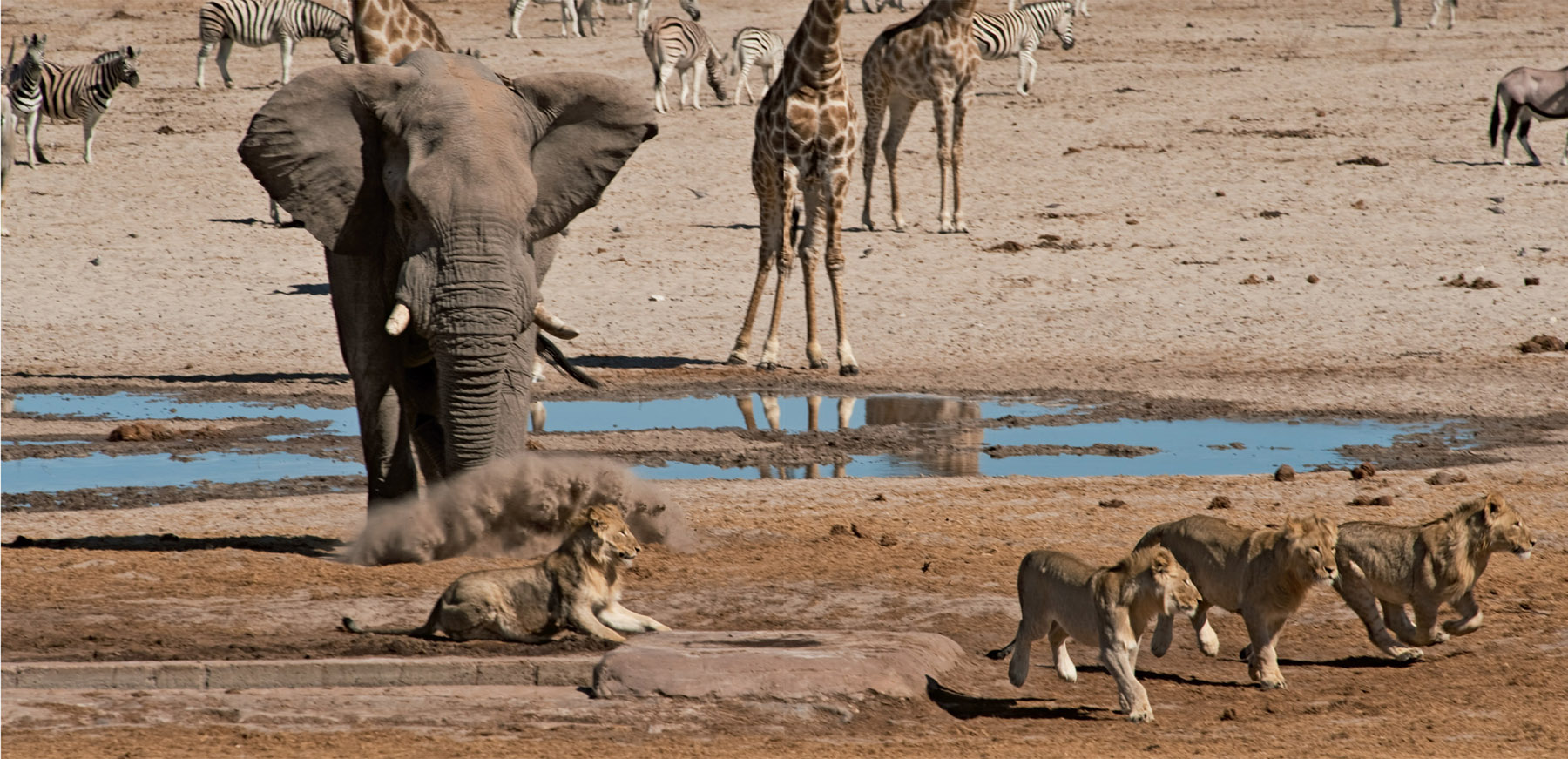
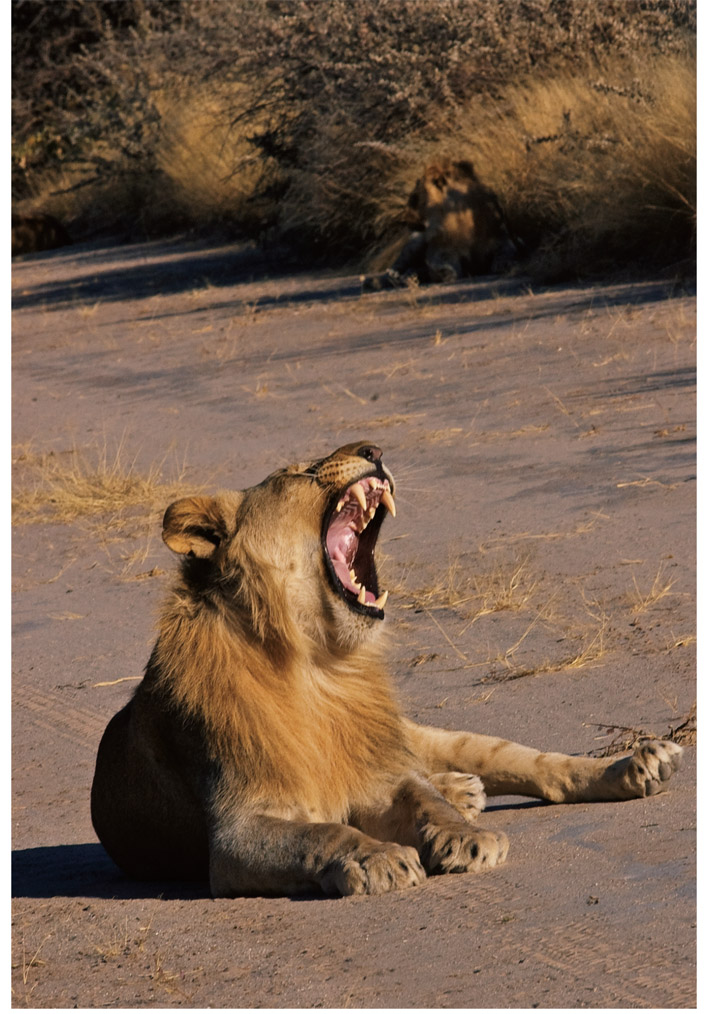
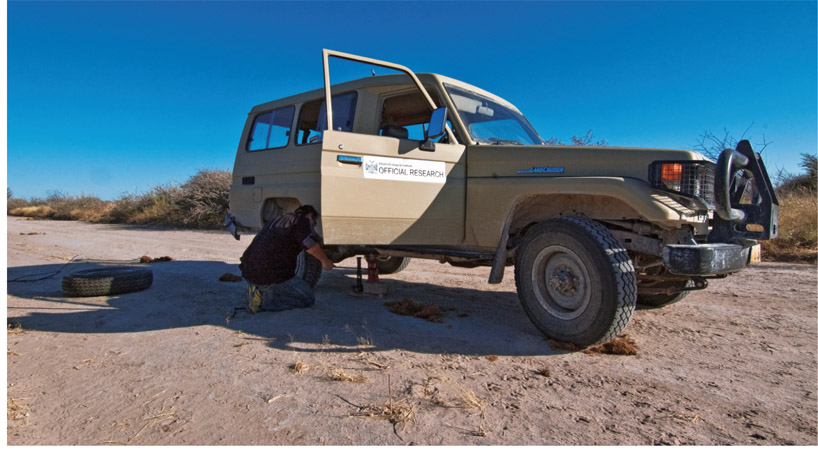

During our safaris between Mushara and the closest waterhole, Kameeldoring, occasionally we found ourselves in the middle of a feud between the pride of lions that is trying to claim Kameeldoring as their territory and the group in flux at Mushara, whose range extends to Kameeldoring. One day, when we were finished with our photo shoot of the feud, I pulled away, only to realize that we had a flat tire and had to change it in the middle of lion country before it got dark, or face having to sleep in the vehicle that night. This is a good example of why it is so important that a field vehicle have at least one working spare tire.
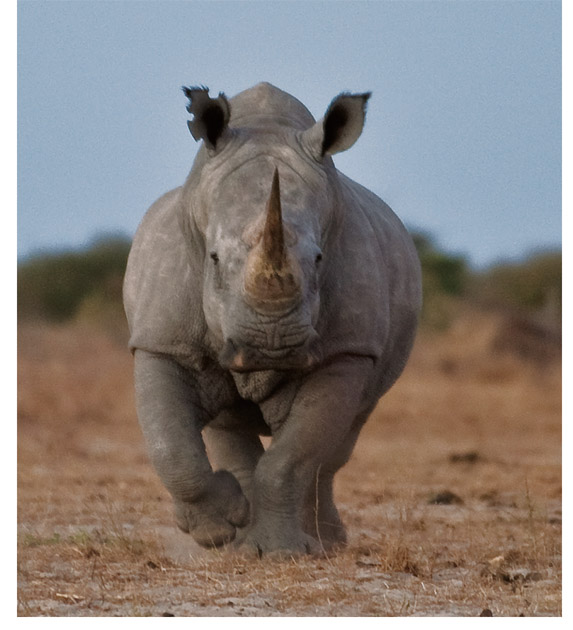
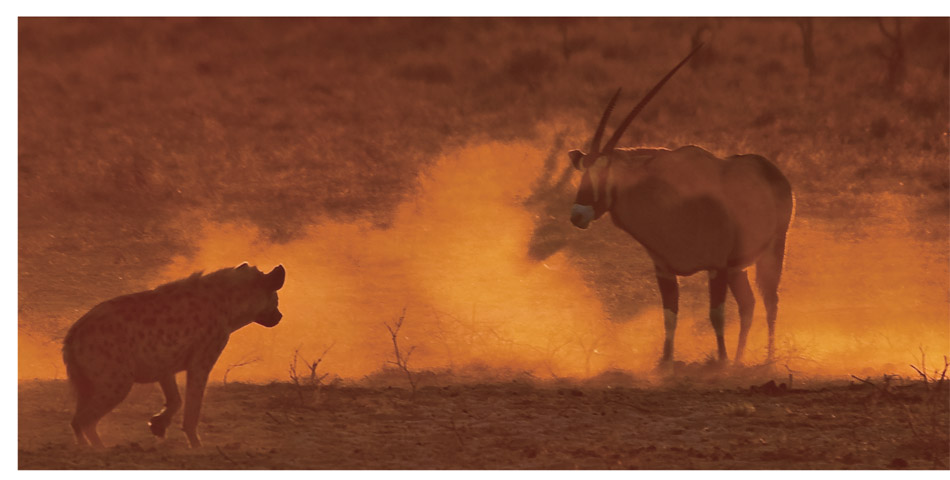
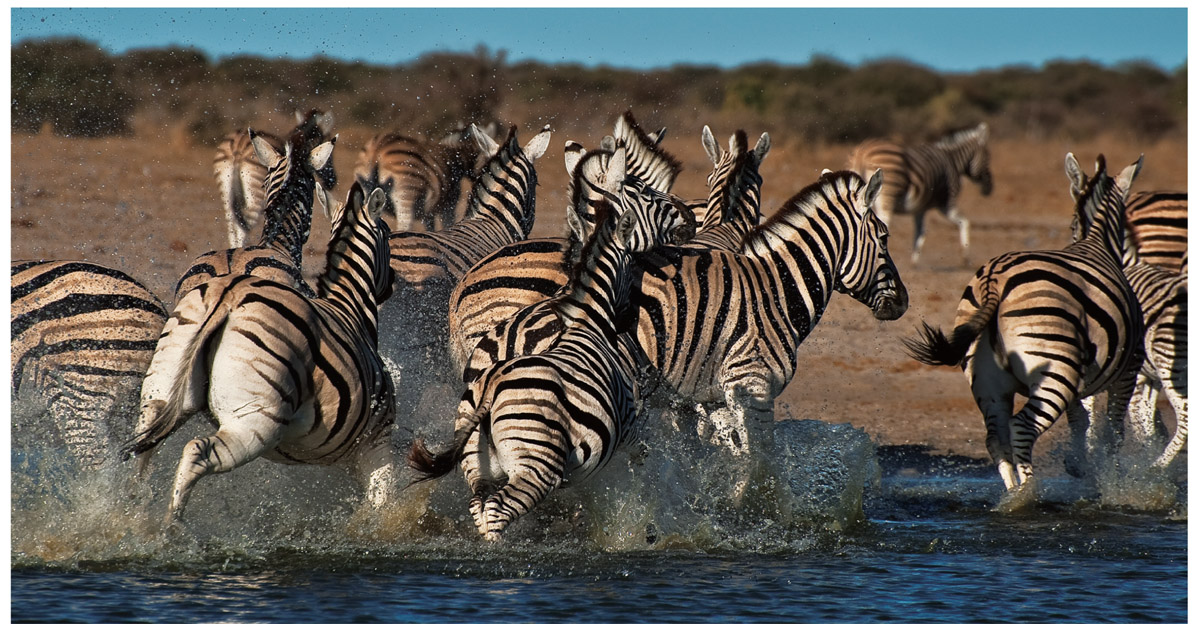
In addition to elephants, Etosha National Park hosts 114 mammal species—such as rhinos, giraffe, zebra, wildebeest, kudu, lions, and leopards—and 340 bird species, more than 100 reptiles, 16 amphibians, and one fish species.
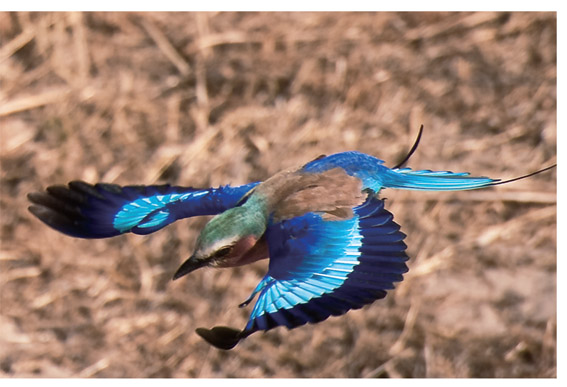
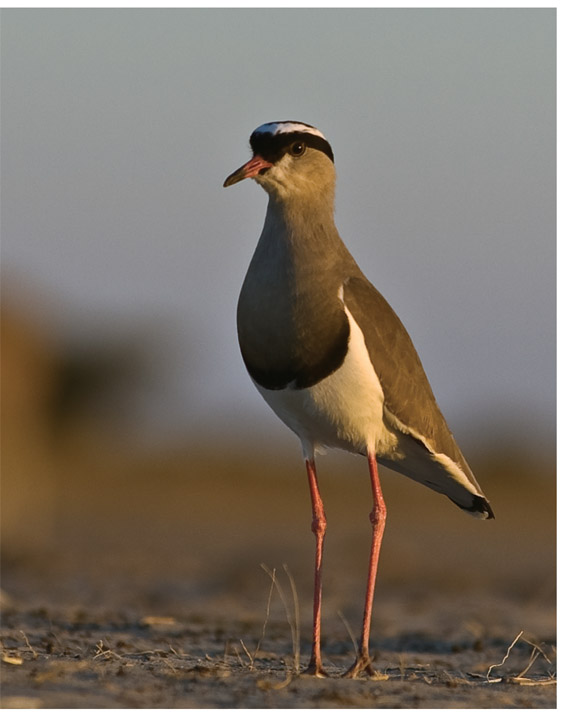
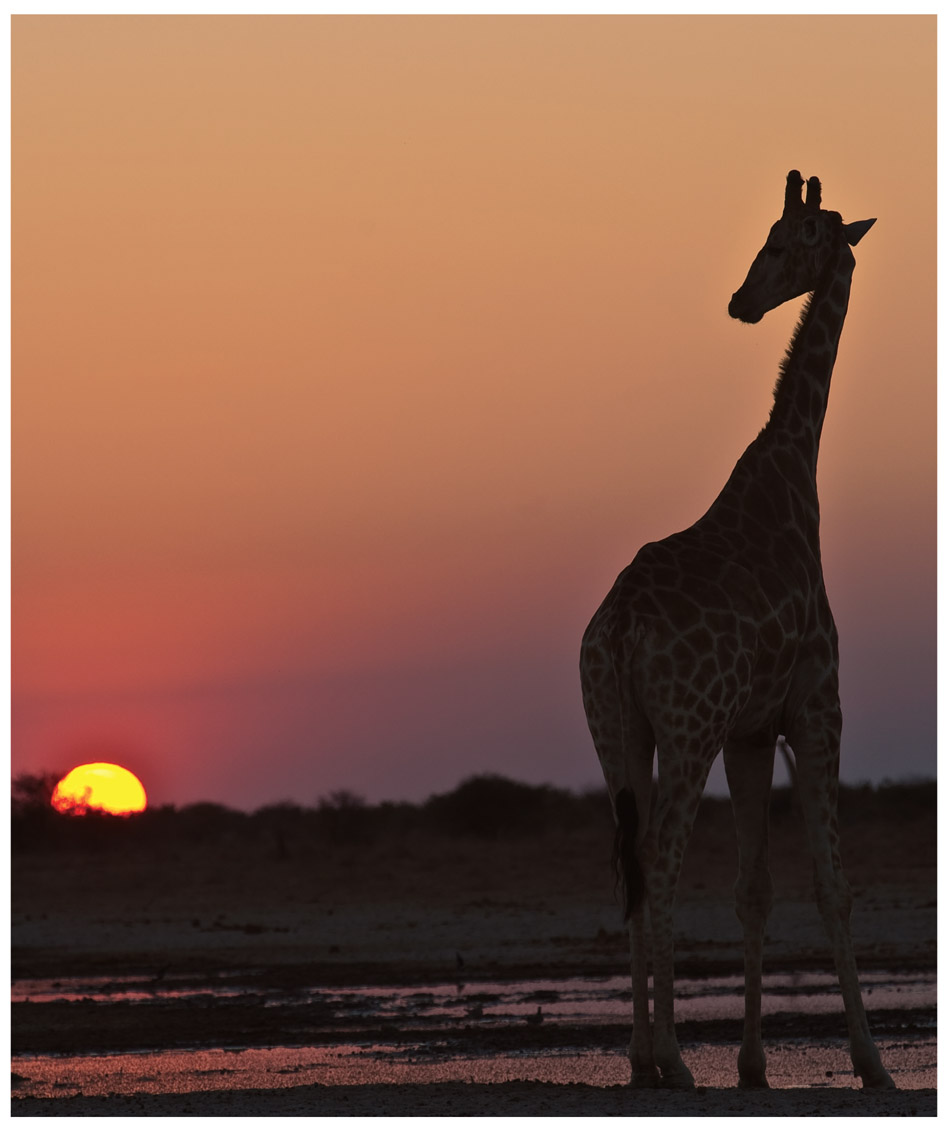
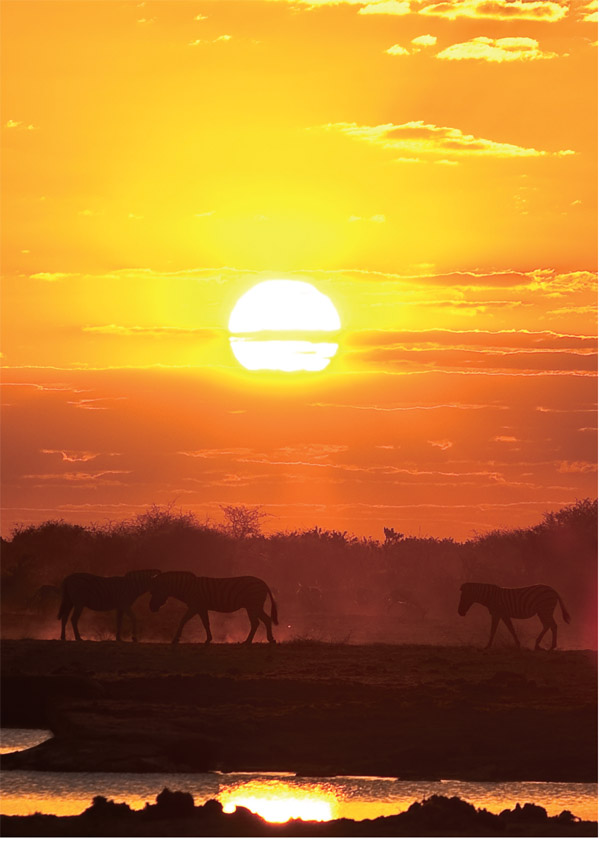
Whenever elephants are not present, there is always a photographic moment to be had with other animals throughout the day but especially at sunrise and sunset.
